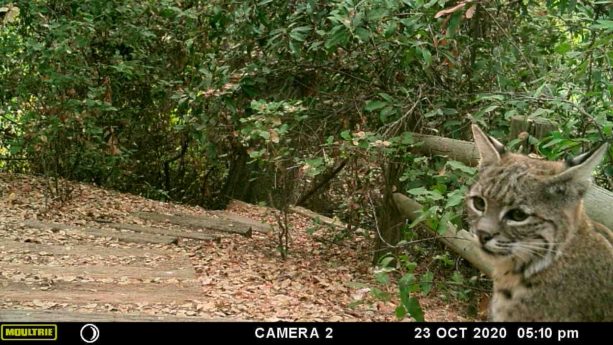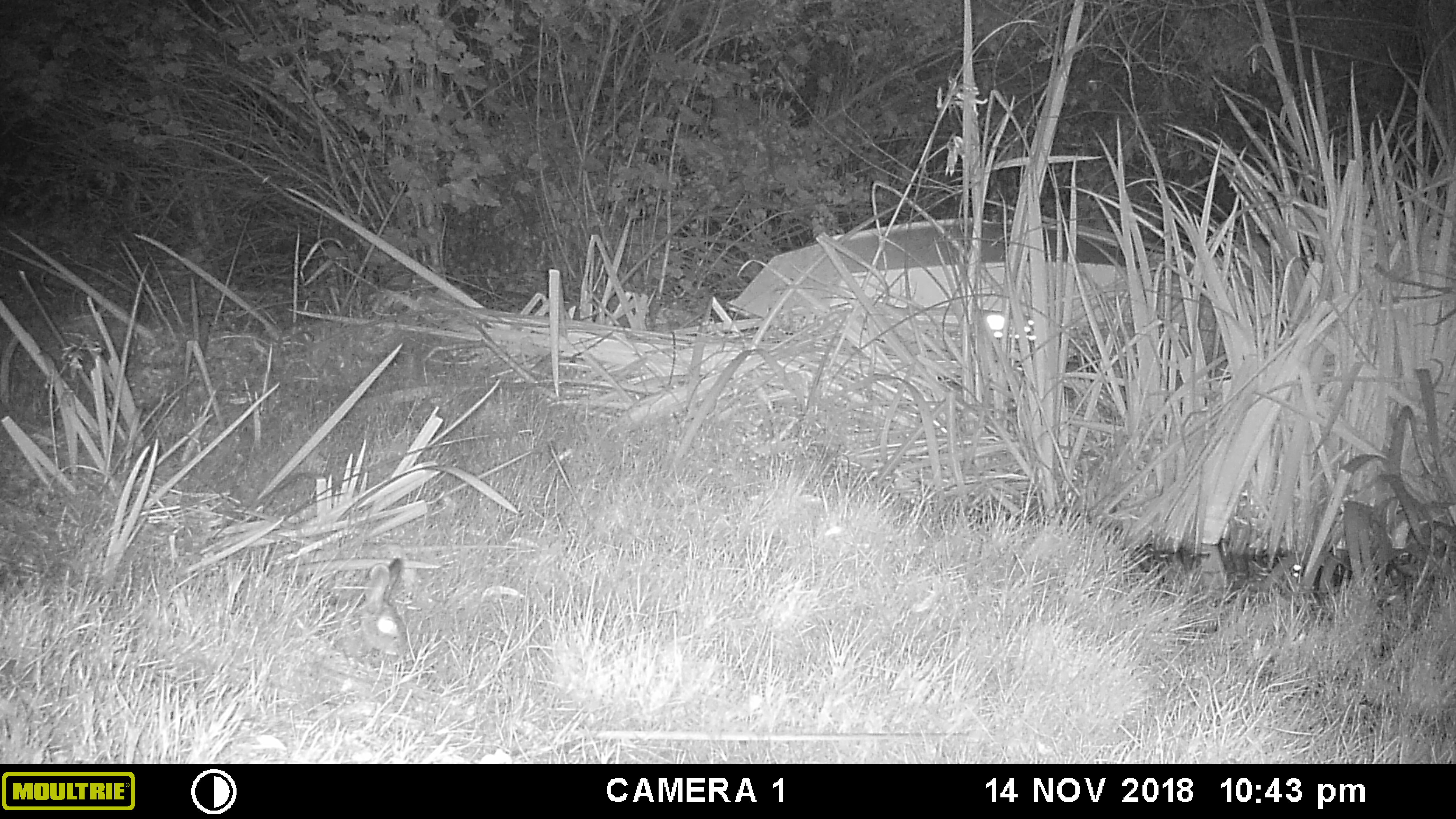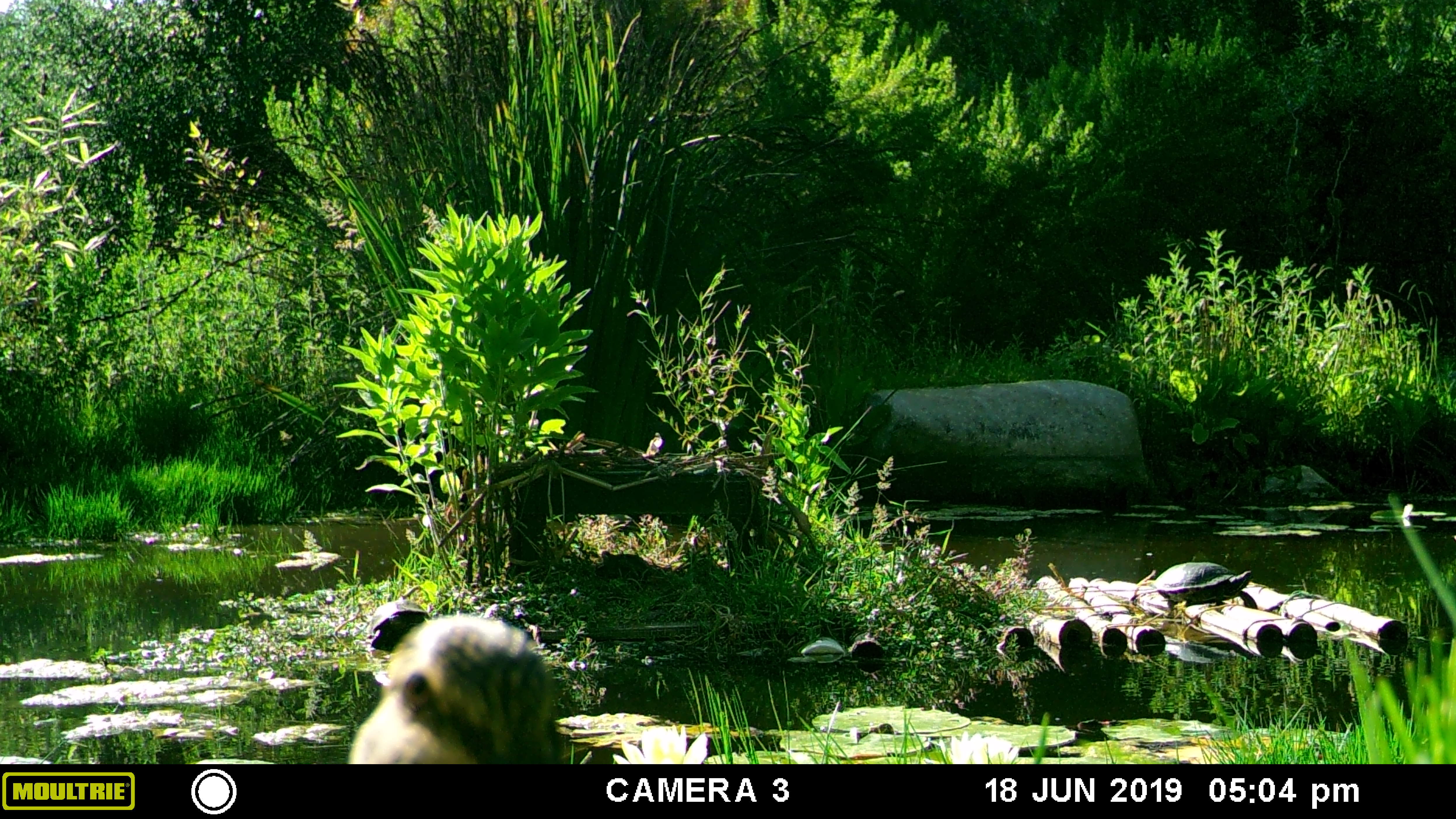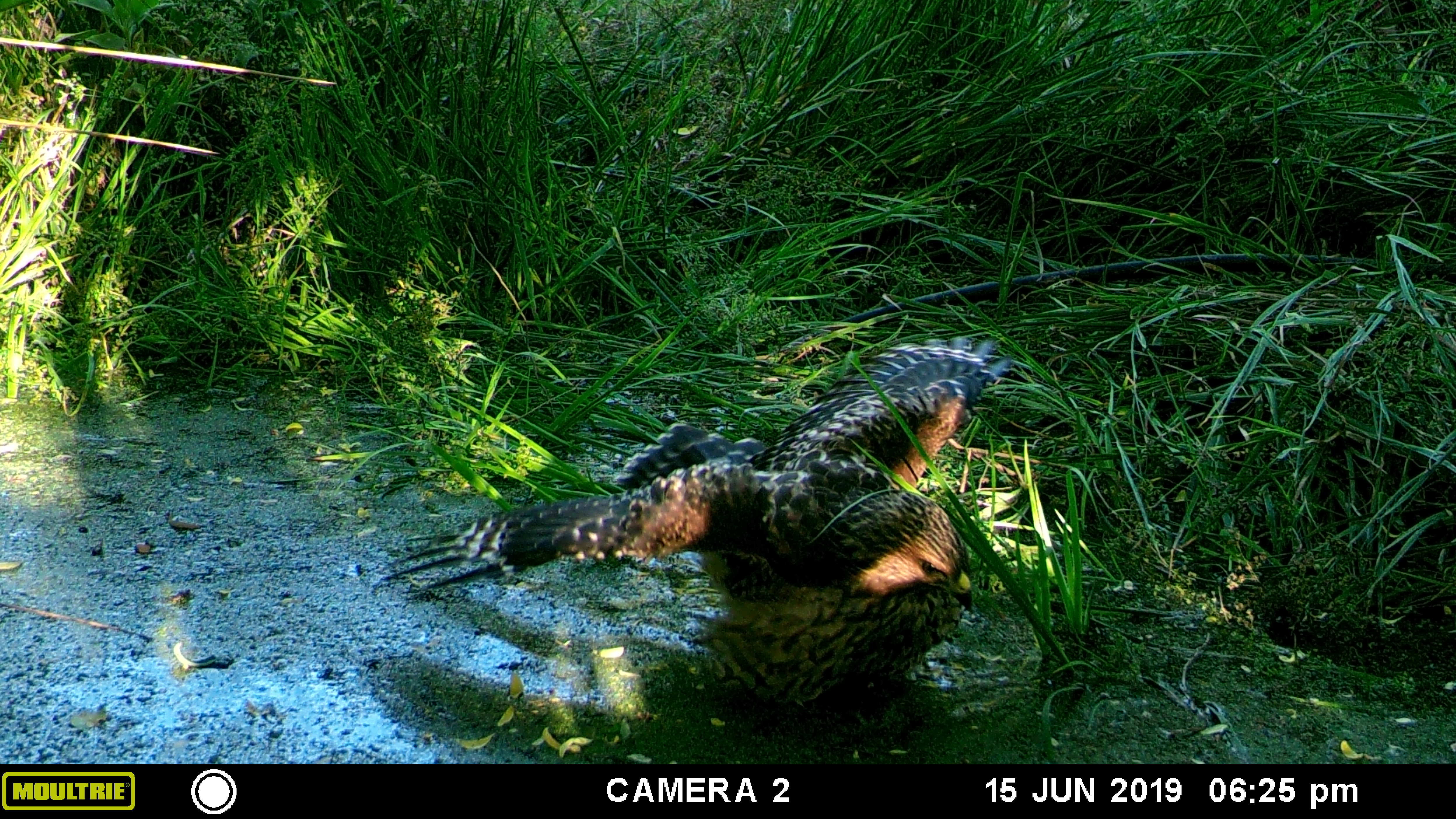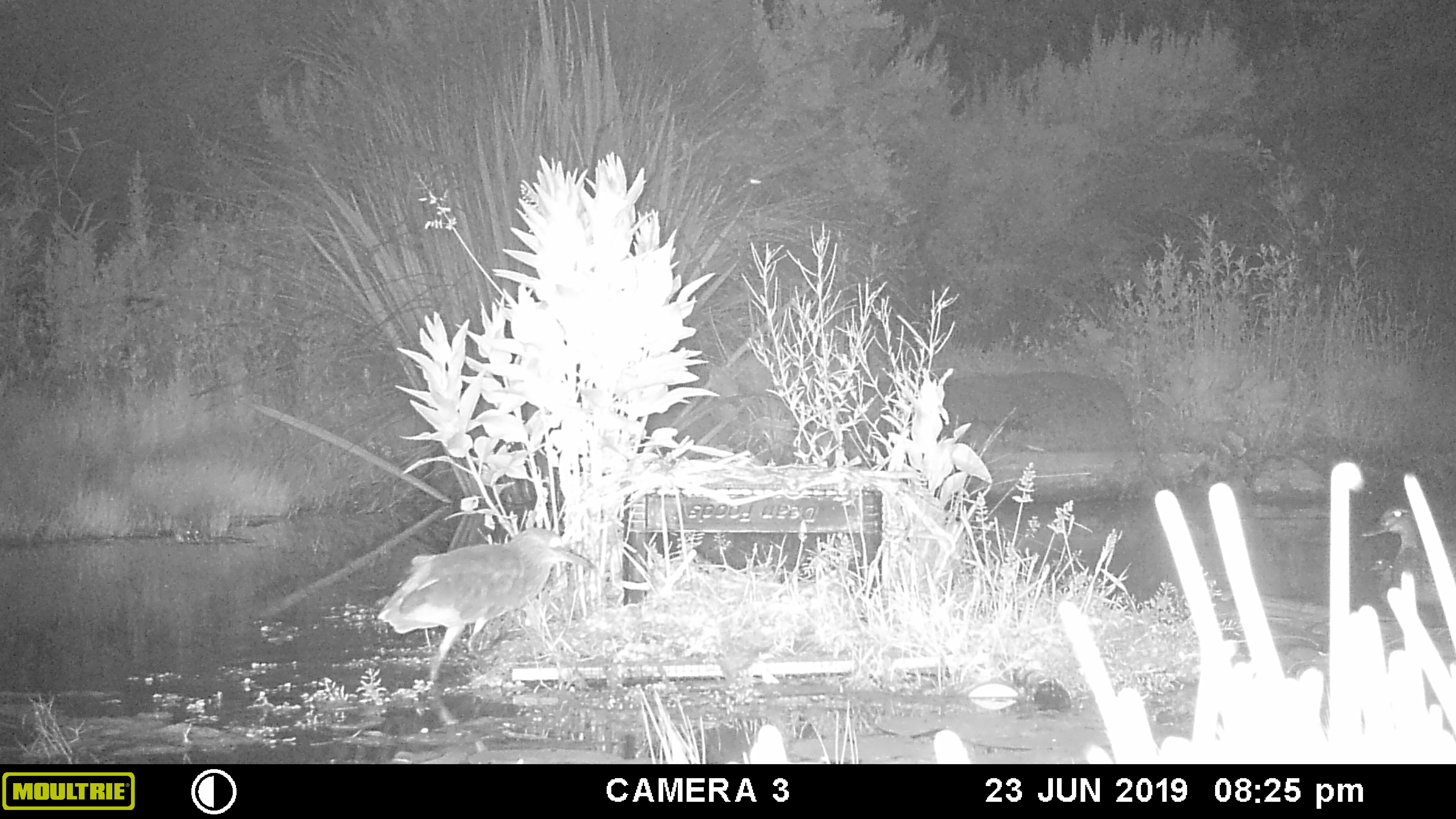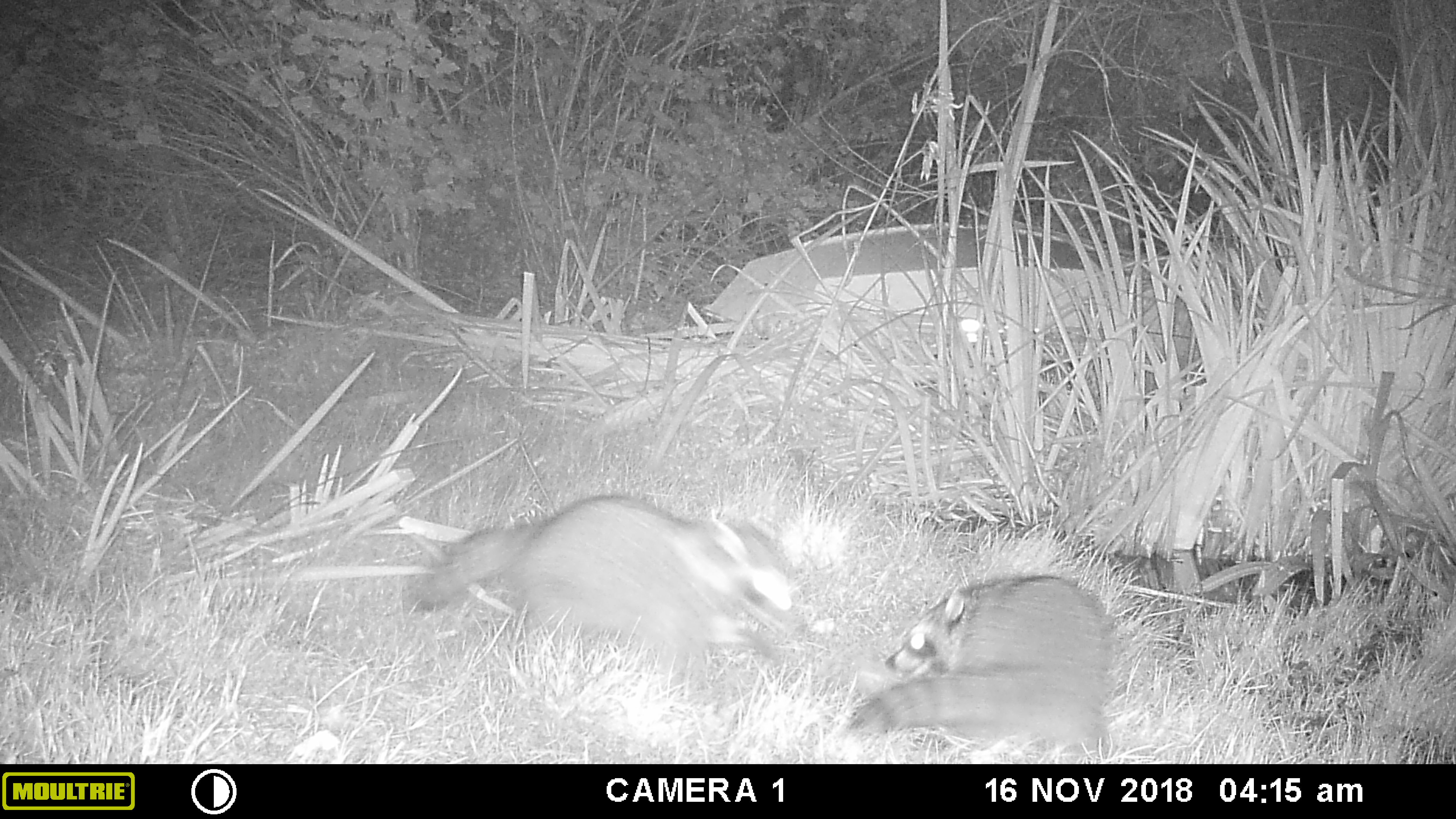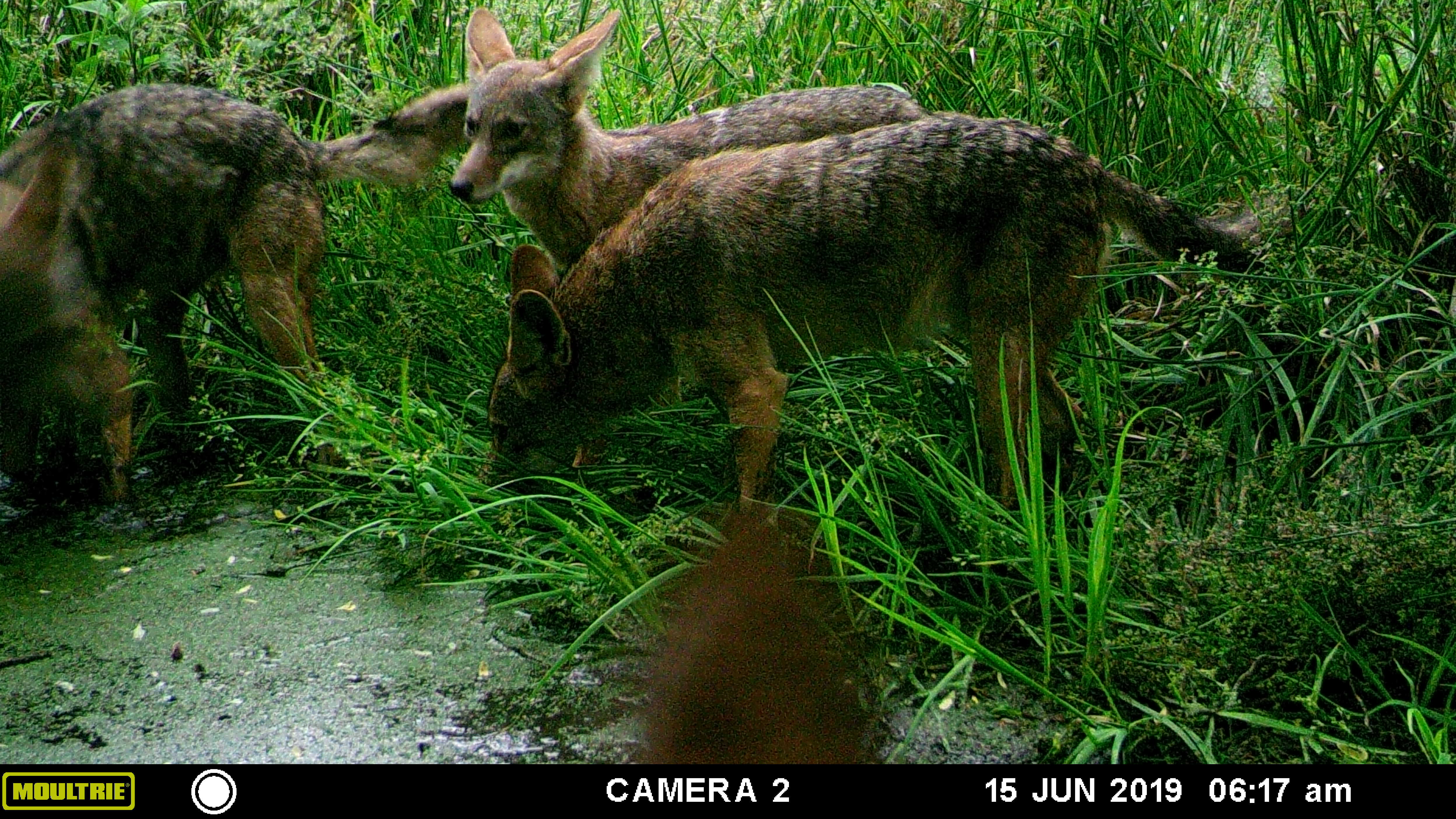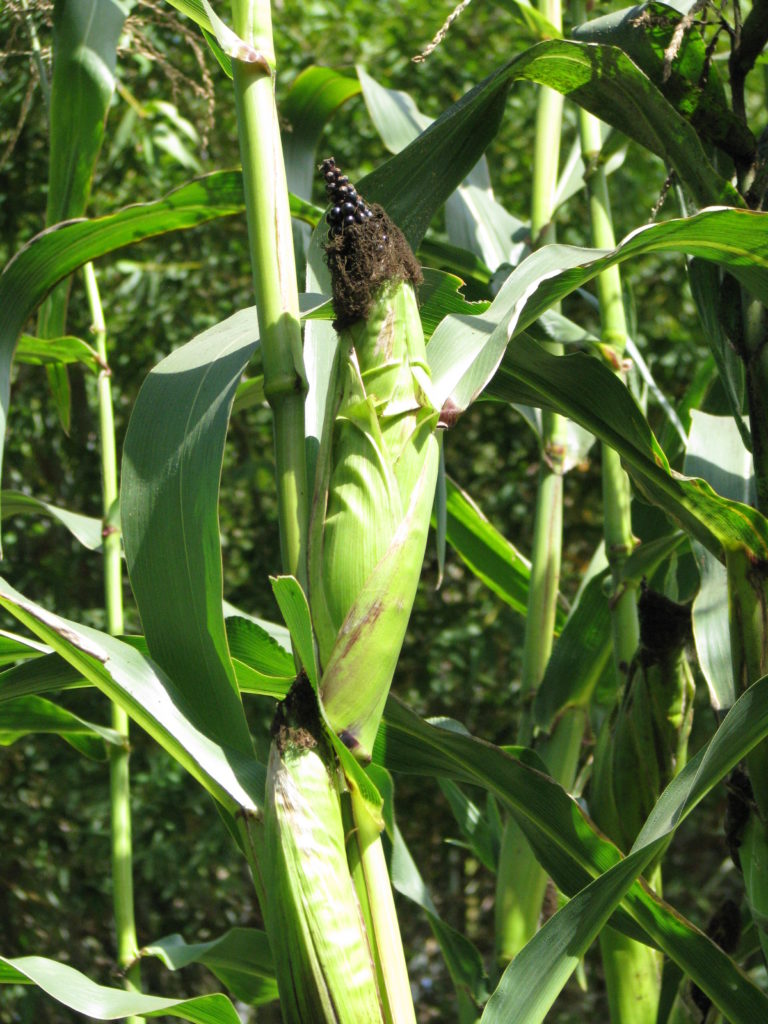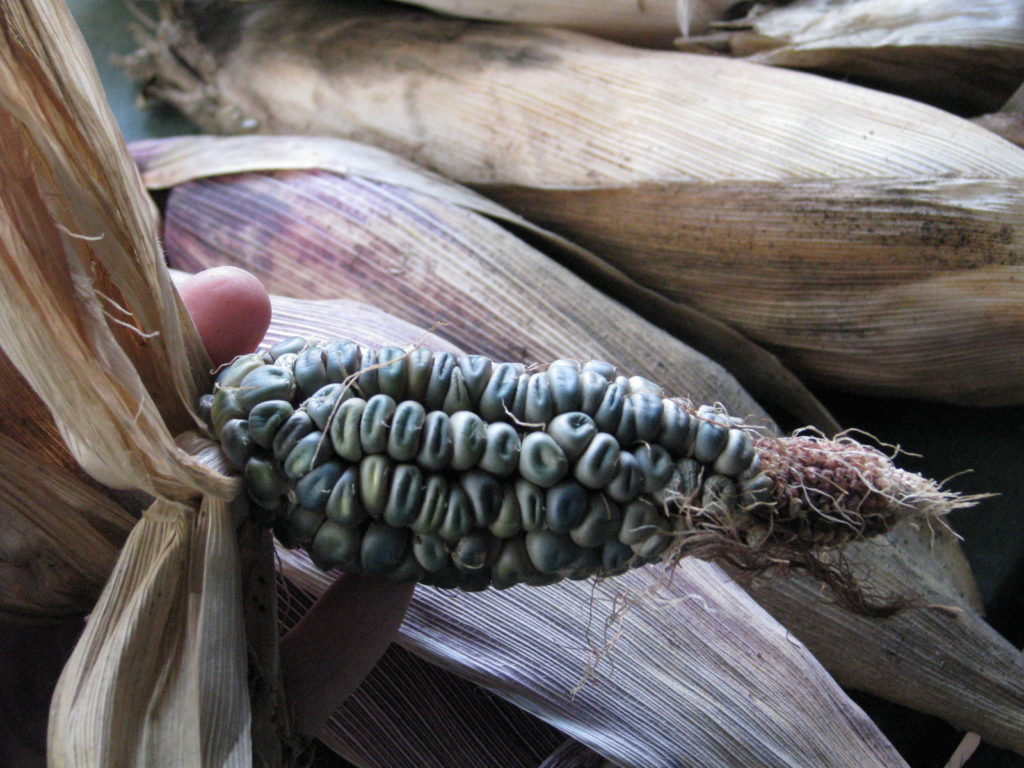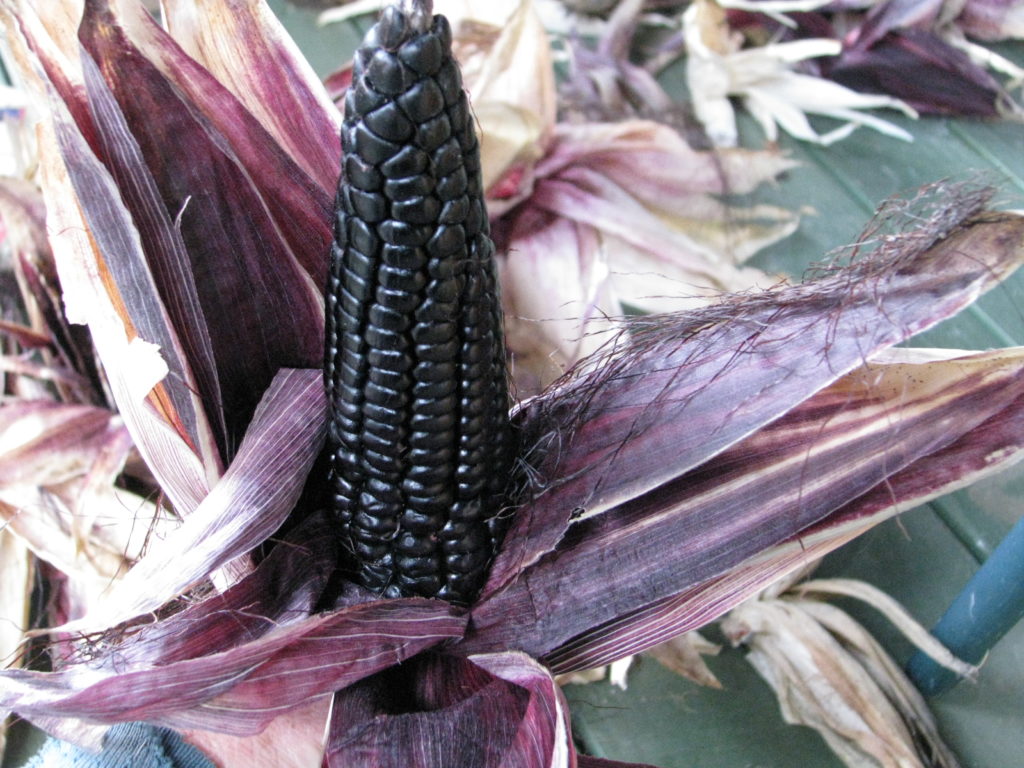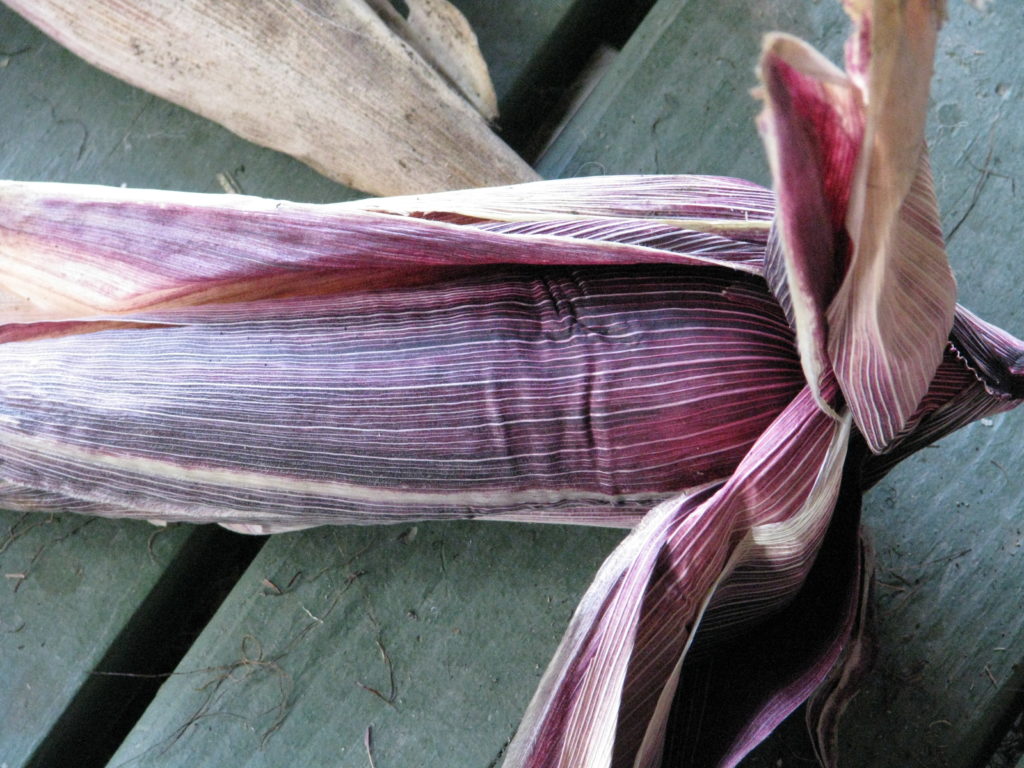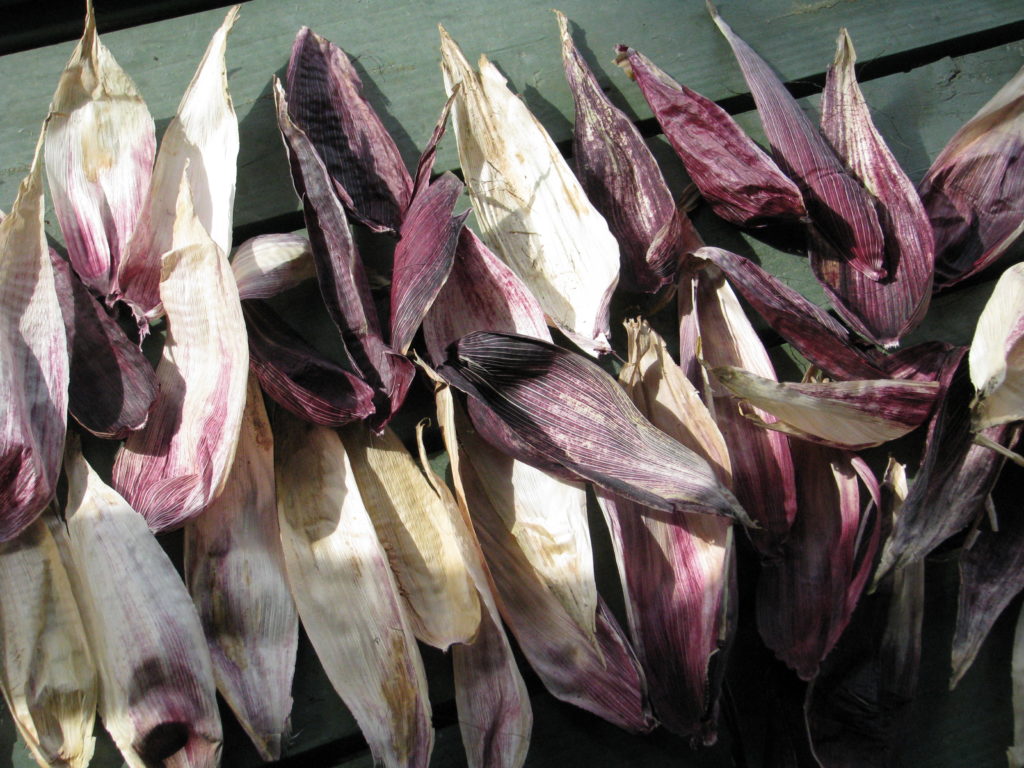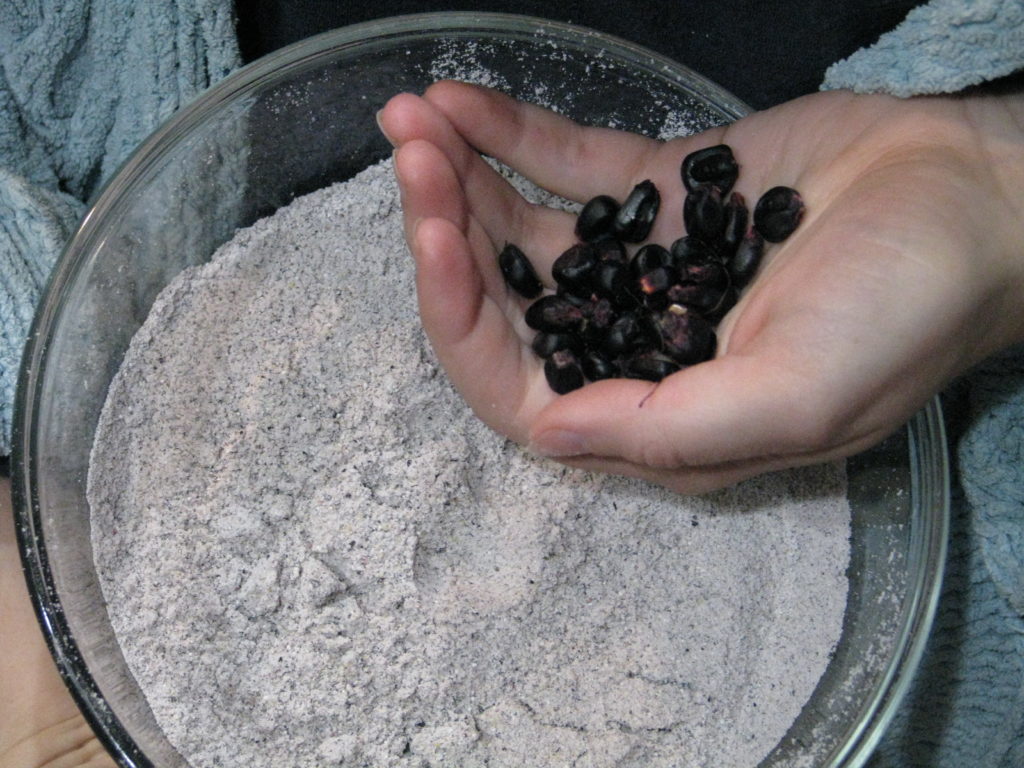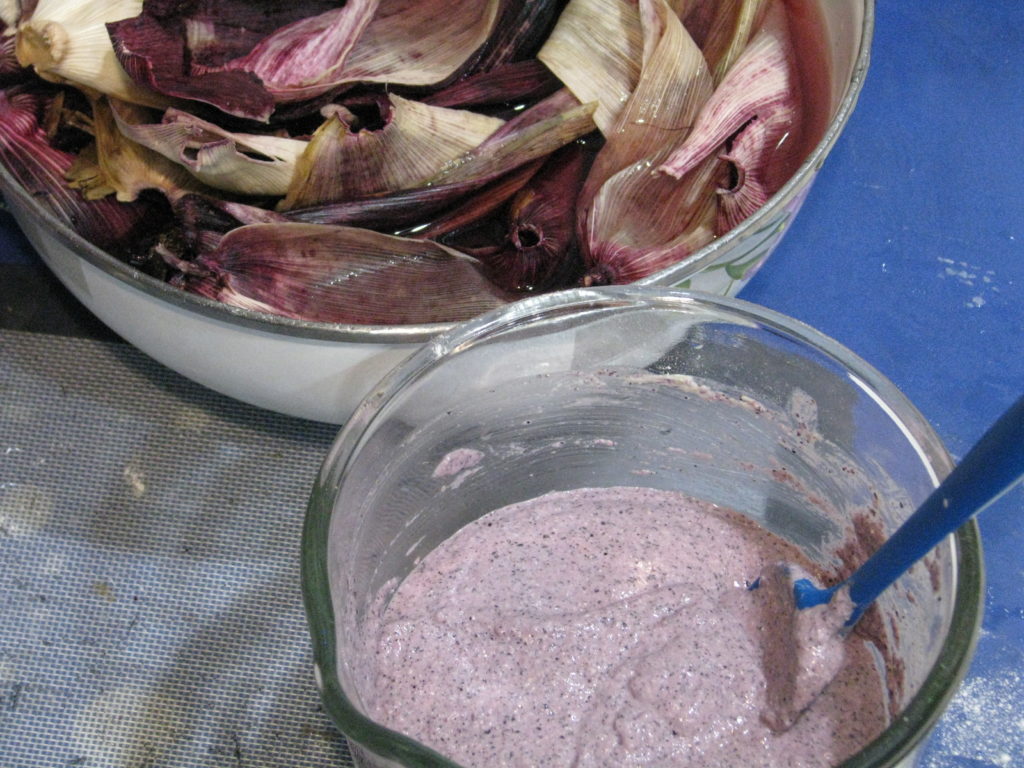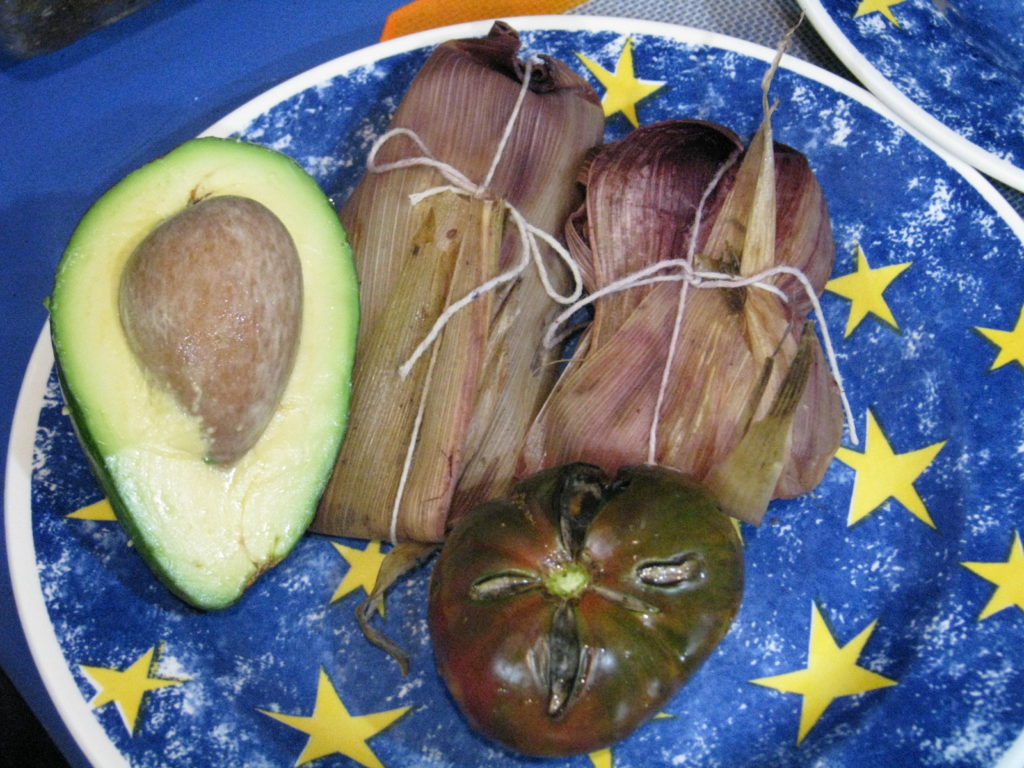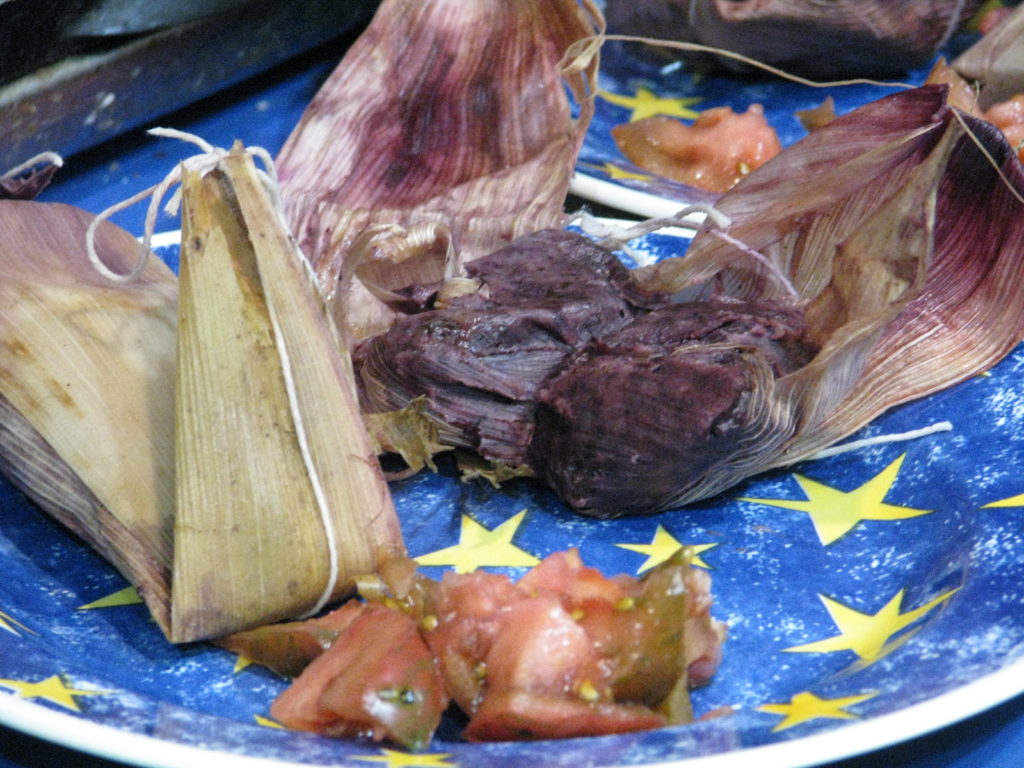-
Mange, Rodenticide and a Bobcat named Daisy
Bobcats are beautiful, shy animals larger than a domestic cat and much smaller than a cougar. Their main food is rabbit, mice, rats and squirrels; given the opportunity they will eat pets and hens if people are careless and unkind enough to allow their pets and hens roam. One bobcat can eat hundreds of rodents a week. They are not aggressive to humans and would rather not encounter anyone, including other bobcats unless it is mating season.
Our property is 1.6 acres, with surrounding lots of similar size and only a couple of miles from town. There is a busy commuter road close by. It is not prime wildlife property. At the bottom of our property there is a seasonal stream where we have encouraged natives to thrive, including an old Coast Live Oak (Quercus agrifolia).
A couple of years ago while watching the short videos from our wildlife camera set up on the stairs leading past the oak and down to the streambed, we cried out in delight when we saw a beautiful bobcat. We named her Petunia. (Time and date signatures on the camera are not accurate, as they reset when batteries go low).
That bobcat gave birth to a little male who delighted us with his kittenish tricks, including sabotaging his mother who puts him in his place. Our palm trunk stairs make great scratching mats. Cats will be cats!
The male, Jonquil, quickly grew up and late last year during bobcat mating season we were delighted to see a young female bobcat. We named her Daisy. Love was in the air. Daisy showed signs of being pregnant in early spring.
We were ecstatic that we were helping to offer habitat to allow these beautiful creatures… who were also helping control the rodents,.. the safety to reproduce. San Diego is one of the most ecologically diverse places in the world. Due to human usage it has been called an epicenter of extinction. Therefore any preserved viable habitat needs to be cherished. Between the years 1970 and 2010 the world lost 52% of its wildlife population across the board, according to a study by the World Wildlife Fund. That figure is now up to 60%. Look at a flock of birds and double it in your mind: that is what should be here. Look at the lizards, the frogs, the seals, the fish, the snakes, the deer…. there should be at least twice as many. The wildlife is disappearing at an alarming rate, and having bobcats reproduce on our property was a miracle.
Then we saw a sign of mange on Daisy and our hope disappeared.
We knew it was all over. Mange is a disfiguring, painful and deadly condition caused by burrowing mites that get under the skin and reproduce. There are several kinds of mites affecting different animals. My mother’s dog had mange and to control it took many long soaks in a miticide-based bath and strong antibiotics. Mange causes the skin to lose hair and crust over in painful and itchy lumps. The animals become lethargic and cannot consume enough calories to be healthy. Infection can set into the wounds. Hearing and eyesight will be compromised as mange surrounds the face. Eventually the animals starve as they are in agony from the pain and itch, and their organs begin to shut down. Its a long and painful death. We knew we had no way of trapping Daisy and bringing her to the Humane Society for treatment although we placed a call to them anyway. When we saw Daisy again the crust had advanced and she no longer had her ‘baby bump’. She was lethargic and looked ill.
In June when down in that area of the property I heard thrashing in a bush near me. It was Daisy. She was covered with mange, emaciated and too weak to stand. I was able to wrap her in a towel, get her into a cage, and Miranda and I took her to the nearest Humane Society although we knew it was too late to help her. Euthanasia helped her pass quickly although I don’t think she even knew what was going on anymore. The following video is emotionally hard to watch. It was taken with my phone camera down through the top of the cage just after I’d moved her to transport her to the Humane Society. Understandably I was enraged and distraught.
A healthy immune system helps bobcats and coyotes keep the population of mites under control. What is the main reason bobcats and coyotes get mange here? From eating rodents that died from ingesting rodenticide. Rats, mice, gophers and squirrels who have been poisoned usually die in the open, and for hungry predators including hawks, owls and carrion eaters such as vultures and condors, its an easy meal. The poison continues to work on the predatory animals. Hawks, owls and other birds and smaller animals will die more quickly and directly from the rodenticide, as will their nestlings to whom they feed the poisoned animals. Larger mammals such as bobcats, coyotes, foxes and bear have their immune system compromised, as well as having some internal damage done upon ingestion. Illnesses such as mange then take over giving these marvelous and necessary creatures a long, slow, painful death. Mites will drop off and move to other mammals as well, so an animal sick with mange will more likely spread the infestation, just as a sick human is more likely to spread germs to others.
I have pleaded with customers at hardware stores carting out buckets of poison because the squirrels ate their peaches, or they have mice under their house, but they don’t really see the problem. If they saw the dead hawks and owls in the parks that we who work and hike in parks see, and saw the mangy coyotes and bobcats as we do, then maybe they wouldn’t do it. There are many ways of reducing rodent problems without using poison. Rodenticide should be outlawed, and unfortunately it will only be until bobcats and coyotes become endangered that maybe something will be done about it. Rodenticide will always cause a secondary kill. Period. Please read this excellent article by Miriam Raftery for East County News. The handful of poison that you throw out will kill a fraction of the rodents, but it will kill predators who will eat them, and those predators would kill thousands of rodents over their lifetimes. Please don’t use poison. Please insist that others stop using it as well. Please try to convince hardware stores to stop selling it. Please.
Here is a post about protecting your plants and home without using poison: https://www.vegetariat.com/2022/09/protect-your-plants-without-using-poison/
Update 9/1/22: Sadly, our wildlife camera has picked up photos of Jonquil, the male we saw raised from a baby, with signs of mange around his face.
- Animals, Birding, Gardening adventures, Integrated Pest Management, Natives, Planting, Quail, Water Saving
Native Plant List for Birds
Photo by Miranda Kennedy
Today Miranda and I (mostly Miranda!) spoke about native San Diego plants that were best for birds. Miranda’s excellent bird photography and her in depth knowledge of wildlife behavior made our talk for the Audubon San Diego Bird Conference very informative. She is always fun to speak with, too. We presented a slide at the end that listed plants that were featured in the presentation and I promised to post it here. By no means is this an exhaustive list; birds will take advantage of any resources they can to survive. However these plants can be purchased and planted in landscapes (we notably left off the poison oak in the above photo, which is a excellent food and habitat plant, especially for towhees who prefer to nest in it!). And here it is:
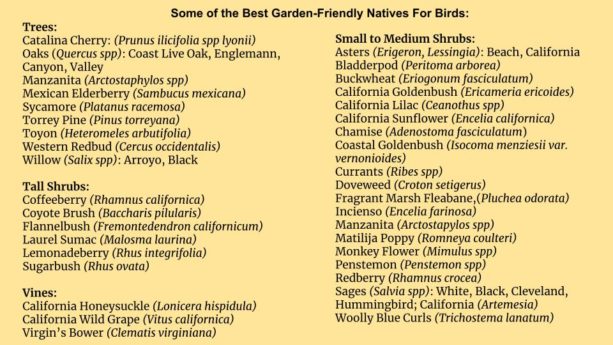
-
Pruning: the basics

A young peach tree volunteer, pruned its first year for height and health. Pruning is a point of contention with me. If you plant a plant in the right place, meaning that it has room enough to grow to its full potential without having to be constantly cut back, then you really won’t have pruning issues. So often I see trees being used as hedges right next to houses or pathways, so they have to be butchered regularly to keep in shape. Because the tree is supposed to be large it produces a lot of woody growth, and over time that is what you’ll see: lots of cut wood with a layer of leaves over the top. Or thorny plants right next to pathways. Or trees with invasive root systems, such as Ficus, California or Brazilian Pepper (neither from California), or eucalyptus, planted right outside a house or near the septic tank. These plants are aggressive in how they find water and they will lift pavement. So understanding the nature of the plant through research, not just what the employee at the garden center has to say, is important so that you aren’t planting an expensive and possibly hazardous problem. If I could wave a magic wand and eliminate 90% of the above-mentioned trees in this state and replace them with drought-tolerant native trees, I’d have no hesitation.
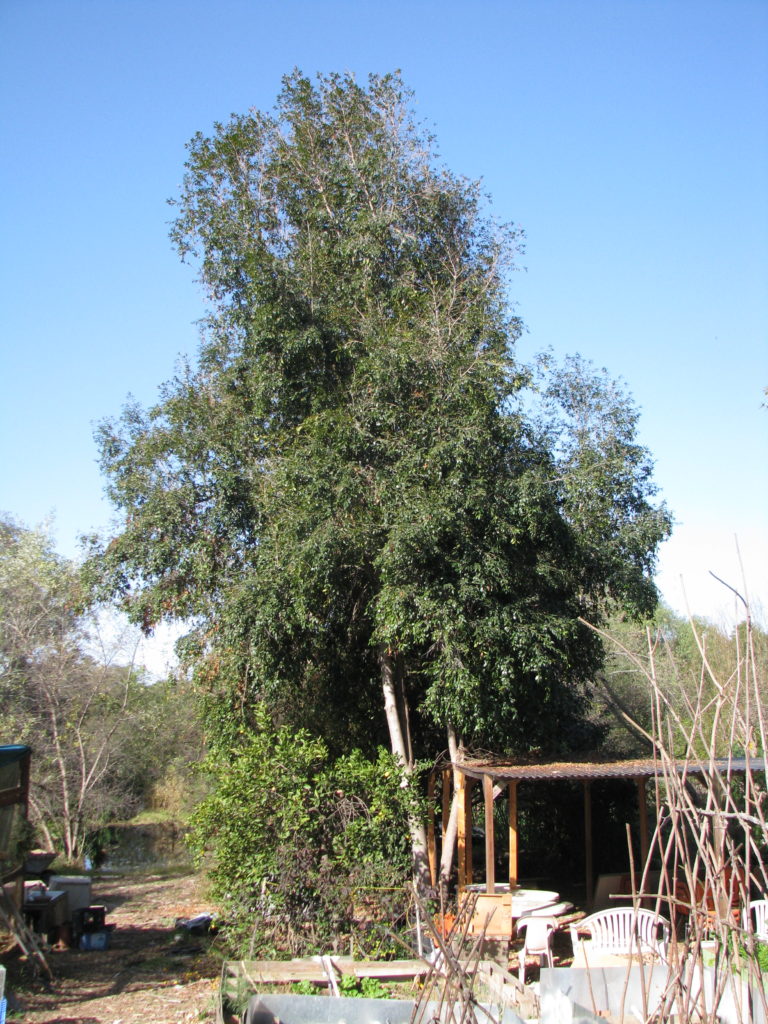
This is eugenia, which has a pretty white flower and red edible berries. I’ve seen this tree planted in multiples between a house and a sidewalk in a 2′ wide planting strip and kept to a 1′ x 3′ square, and planted there by a professional landscaper. Unbelievable. Back to pruning and away from my tree-placement rant.
During my consultations I hear clients say, “This tree needs pruning.” I ask them why they think so, and often they really don’t know. They feel that they have to control the tree somehow, or that human intervention is required. My response is usually, save your money and the preserve the health of the tree by NOT PRUNING. When you make a wound in a plant you open it up for disease and insects. If you continue to change the nature of the tree it will be stressed, and then you will have more insect and disease issues. So please, just leave the trees alone, in most cases.
A horticultural teacher once explained that lawns are partially there for stress control. A person rides through aggressive traffic twice a day, works at a miserable job with miserable people, comes home to messes, a cranky family and bills, has weight issues. So on the weekends he or she can break out the lawnmower and cut that grass down, keep it the same size and make it obey. They have some control over something in their lives, and making that grass immaculate is possibly the only thing standing between them and the loony bin. Over the years from what I’ve seen, I have to agree with that teacher, and extend the example to tree and shrub pruning as well.
When you have young fruit trees, you are planting them for production. You are using them as livestock, so manipulating them for maximum yield is probably on your mind; however, long life and chemical-free growing should also be on your mind, and again, resisting the urge to chop away at your trees is the best bet. Don’t take advice from those in the food-producing industry because they are maximizing their crop for sale using every means they can, including having a short life expectancy for their trees which they will replace at projected intervals. Backyard fruit production is different. You want fruit, but a nice-looking yard as well.
Before you begin, be sure that you have sharp tools that are up for the job. Hand pruners for small stuff, loppers for 1/2″ – 1″, and saws for larger branches. ALWAYS bring Lysol or a bleach solution to clean your blades so that you won’t spread any disease between trees, and treat your blades between each tree. Keep your tools sharp and don’t twist them when cutting or you will mess up your blades. Wear hand, eye, arm, and breathing protection because those little bits have a way of fighting back. For larger limbs, head protection as well. Its better to look like you are ready for a nuclear explosion than to be injured by snapping branches, thorns, falling debris, and even angry insects or birds.
Understand what you are pruning. Many fruit trees and berries fruit on second-year wood, so if you cut it all off, you won’t have blooms. Just because something doesn’t have leaves on it doesn’t mean that its dead; many plants have late dormancy, or go drought dormant in the heat of the summer. If you lightly scratch the bark with your fingernail and there is green underneath, it is alive.
Prune to a node. A node is a growth point. Aim for one that is facing out or to the side, rather than into the plant.
Cut close to the stem, but not right up against it. There is a collar at the base of each shoot, and if you cut just above that, then that will callus over. If you cut into it, it will leave a wound that can be infected. If you leave a stem, that will die back to the node and in doing so may bring in fungus or insects. If you are cutting something heavy, then make an undercut first, then make another cut on top further along the branch, and then the weight of the branch won’t make the bark tear and rip down the tree. Make a final cut close to the collar.
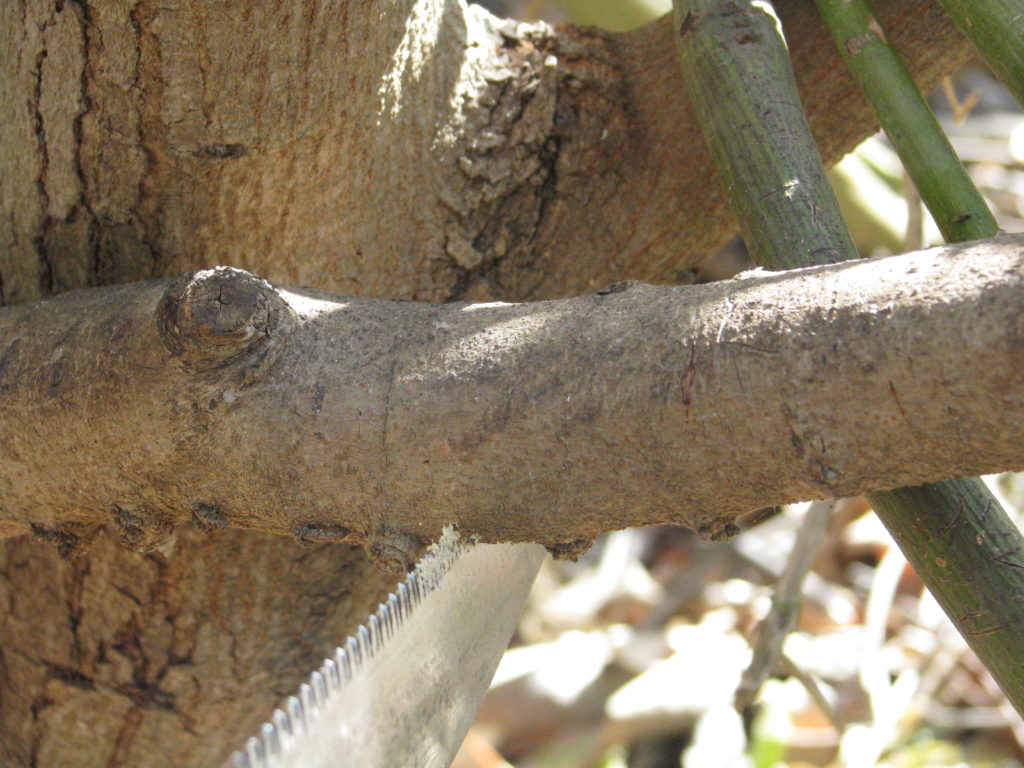
Undercut to prevent the bark from ripping. 
Make the top cut away from the undercut. 
Make the ‘clean up’ cut now that the weight is off, close to the node or collar. Slanted cuts will repel water. The basics for pruning are, for new trees, cut off dead wood. If you have large ornamental trees, you don’t need to do this unless there is disease or insects in the dead wood, or there is a threat of large dead wood falling on someone. Otherwise, don’t feel the need to ‘clean up’ the tree. Most of the insects and fungus that will inhabit that wood are benign, and actually help with the health of the tree and the ecosystem around it.
Cut off diseased wood. If there is a black or brown ooze from a branch, have it identified. It is probably a fungus or an insect. It may be easy to control, but you have to know. Burn, hot compost (150F – 170F), or bag up and throw away that wood so that you aren’t spreading a pathogen.
Cut crossing branches that are rubbing up against each other and will open wounds on the bark. Also, trim some branches that start at one side of the tree and grow through the middle to the other side. They aren’t doing the plant any favors.
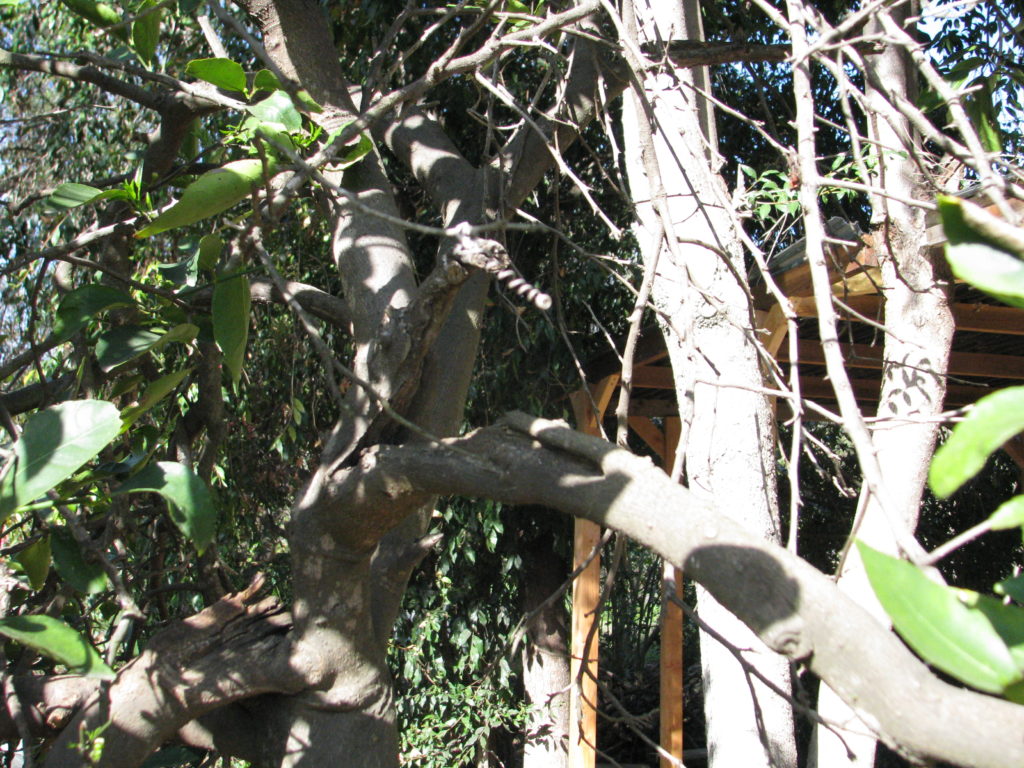
A branch broken and torn from too much fruit weight combined by winds. After you do these quick pruning jobs, usually you have very little to do in the future for maintaining your trees. If you have pine trees, please research the type you have to know if they will regrow at the pruning points or not. So often pines are butchered and they won’t grow back where cut. Or the idea is to ‘give them air’. We have Santa Ana winds, for heaven’s sakes, not muggy conditions that build up fungus like Chicago. Most non-native pines (to S. Ca.) thrive with humidity, so ‘cleaning up’ the pine to allow air flow will just stress them out even further by drying them out. (Also, many pines such as sequoias won’t thrive in S. Ca. because of our alkaline soil and alkaline water. They will live for awhile, and then their root base just can’t feed the growing top of the tree which is supposed to be huge due to the inability to obtain the nutrients they require from our non-acidic soil conditions.)
Many people prune their fruit trees down for height so that you can pick them. This should be done within the first two years after planting a tree so that its hardwood forms low, and then the greenwood sprouts can be pruned yearly to keep it low. Again, if you plant a dwarf or semi-dwarf tree, then you won’t need to stress out the tree every year.
When you stress a plant, just like when you yourself become stressed, you will have to treat it. Usually people resort to a series of chemicals, each of which incur more issues that will need to be treated with more chemicals. If you stress a tree and it is covered with insects you then spray those insects, which then also kills off all the hundreds of native preditory insects, so that you will have more bad insect and disease issues in the future. The best policy is to plant the right plant in the right place (permaculture is 99% design, remember), understand the needs of the particular plant and meet them, do any corrective pruning at the beginning (they are children and need gentle correction to help them grow strong!), and then provide them with appropriate soil and appropriate water from then on. No chemical sprays! No systemics! No tree torture! Less stress for the plants, and less stress and expense for you.
If you feel the urge to prune, take up adult coloring books or yarn dying, labyrinth walking or birdhouse building instead until the urge passes. When you really don’t feel like pruning then you can logically evaluate your tree’s needs and won’t hack away at it. Its like not shopping while hungry. Enjoy the healthy beauty of your plants and the nature they support instead.
-
August at Finch Frolic

Black Beauty zucchini. This year Finch Frolic has been particularly beautiful. Of course, this year we had to close down throughout the spring. Fortunately we’ve been able to reopen for limited-capacity tours with safeties in place. However, I really miss sharing how lovely the garden is, and I want to let you have a little tour right in your home.

Little Marvel Popcorn. It tastes so good! These photos were taken this morning before the temperature rose; its in the 90’sF here today, in North San Diego County. I apologize for the phone camera, as my good camera is in for repair. I only wish that you could also smell the moist mulch from the light overnight dew, or hear the clug-clug of the crow, the tittering of a flock of bushtits and the scuttling of lizards through leaves, which I experienced as I walked around the garden. All of these friends and so many hundreds more are working the garden today and every day, keeping it in balance.

A blue dasher dragonfly, one of many species that patrol for insects all over our property. Their larvae in our ponds look like little dragons, and they eat mosquito larvae as well. Watercress behind. Our food forest is a low-water-use garden, on poor soil, using no additives to the ground other than occasional compost. There are no herbicides, pesticides or other factory-made chemicals used here, and there are two of us who care for the garden. Most of the seasonal beauty this year is due to the diligence of my daughter Miranda who took seed sprouting to a whole new level even before the pandemic arrived. We rely heavily on the insects, birds, lizards, frogs, soil and water microbes and creatures to do all the work protecting the plants, and the plants themselves to create good soil. All we add is a low dose of salty well water which the humus cleans, and leaves or sheet mulch on top. Our fruit trees receive a dose of blender compost once in awhile. Miranda and I hope that these photos bring you peace and lift your spirits, and that knowing you are looking at a safe habitat that is thriving with life gives you a feeling of security as well. It can be done. Permaculture must be done. Best of health! Diane

From the driveway looking down the main pathway into the garden. 
Lorenziana Gaillardia, to feed the pollinators. 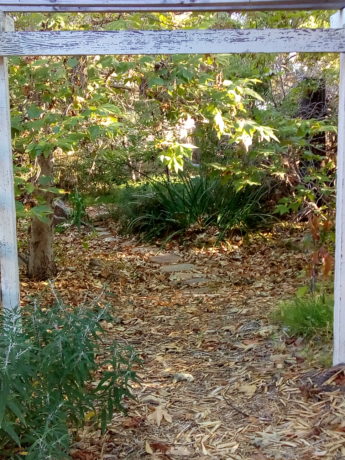
Rock steps cross the large rain catchment basin. Sycamore leaves protect the soil from the heat. 
Our new orchard, with beans trained up a teepee over a fruit tree, and tomato cages behind. 
Our old Ca. Live Oak. Oaks are home to over 300 species of bird and insect. 
Our jasmine-covered gate in the sun. 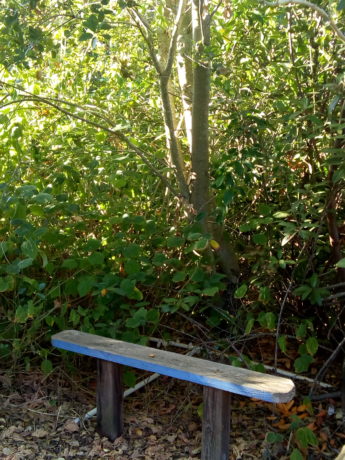
Resting place, made from recycled wood. 
Figs! Panache Striped Tiger. 
Dawn through the birch trees, with Naked Lady amaryllis blooming behind the blackberries. 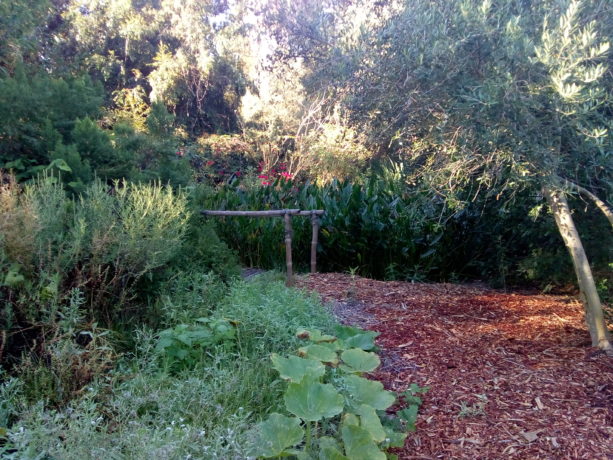
Our small bamboo bridge next to our little pond. 
Dawn through an olive tree. 
A native mallow wildly blooming over a bamboo footbridge Miranda just built. 
Black Krim. 
A plant guild combines plants with different functions for the benefit of all. 
The Torch Tithonia is over 5′ tall, and butterflies and birds love it. A plum, squash and orange tree in the foreground. 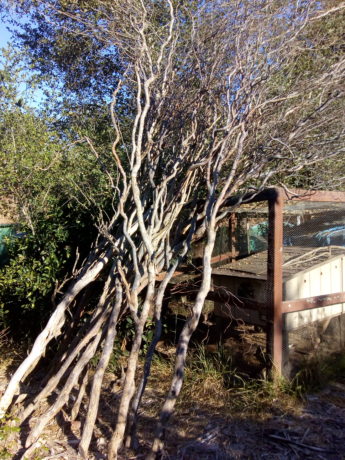
We pollarded our willow trellis in January, and these tall interesting limbs are waiting for some creative project to arise. 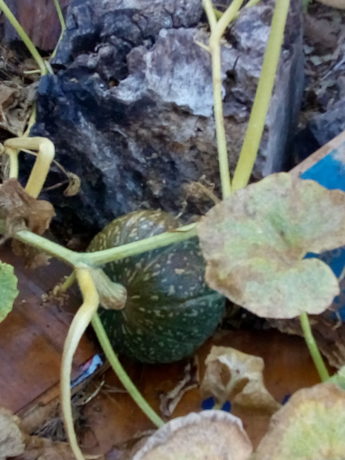
Kabocha squash. 
An army worm taking a sleep in a mallow flower. 
We grow the timber bamboo, and eat it, too! 
This beauty is a carrot, Lunar White, allowed to go to seed. Gorgeous and great food for our tiny native insects. 
Lorenziana Gaillardia. 
Straw flower and carrot. 
Apples do very well in hot weather. Cripps Two. 
Red Kuri squash vine past the seating. 
A whole mess of Naked Ladies! 
Tall Double Mix strawflowers, (Helichrysum bracteatum). 
The Withy Hide, or willow hut. 
Hard to believe that these massive trees grew so quickly. It has everything to do with water capture in the soil. 
This stump has personality! Brachychiton rupestris, Australian Bottle Tree. 
The leaf cover makes this rain catchment basin look full. 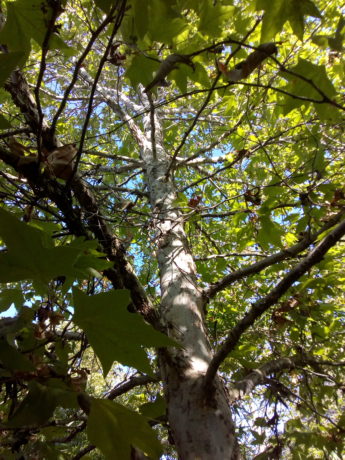
California sycamore, 8 years old. 
A covered bridge over the rain catchment system. 
-
A Video Journey Through Finch Frolic Garden with Kaye Kittrell
We were visited in early November, 2019, by Kaye of Late Bloomer video blog fame. Come have a short virtual tour of our permaculture food forest in the Fall. Please visit Kaye’s YouTube channel, Kaye Kittrell | Late Bloomer Urban Organic Garden Show , to see more of her adventures in gardening. Also, please ‘like’ the video to show Facebook that you care! Thanks for watching.
- Gardening adventures, Heirloom Plants, Permaculture and Edible Forest Gardening Adventures, Planting, Recycling and Repurposing, Seeds, Soil, Varmints, Vegetables
Corn Stalks as Pea Stakes

Our corn grew to a ginormous 10′ height this year in our raised pallet beds. The roots of corn are very sturdy; we usually cut the stalks above the roots, and allow the roots to stay in the ground to decompose. Often they are there a year later, still holding the soil.

Miranda being consumed by corn and zucchini. As it is October and, despite the 95 degree F. temperatures and hot, dry Santa Ana winds that are so typical of Fall here in Southern California, it is time to plant winter crops. Peas are the top of the list to plant. There are many types of peas. Some are valued to be eaten as pods when the peas inside haven’t matured. Some – and these are my favorite – produce juicy round peas that can be shelled and frozen for use all year. Some produce a lot of tendrils, and these along with the new leaves and shoots are eaten in salads and stir-fries, and are very attractive. There are also cowpeas, which are really beans that enjoy warmer weather, so not a candidate for winter crops. Best of all, peas and the rest of the legume family set nitrogen in the soil. They have a symbiotic relations ship with certain bacteria that must live in your soil for this to happen. The plant harvests nitrogen out of the atmosphere, and stores it in nodules on its roots. When the roots die, either from the plant being cut back or dying, the nitrogen is released into the soil in a plant-usable form. No need for chemical nitrogen fertilizers.

King Tut peas are good eating before and after the peas form in the pods. The peas are green. 
King Tut flowers are gorgeous. One of the problems I’ve had growing the tall peas is having the best supports for them, especially in raised beds. I never seem to have tall enough posts, or the posts fall over and chaos ensues. This year we decided that we’d already grown our pea supports: our corn.
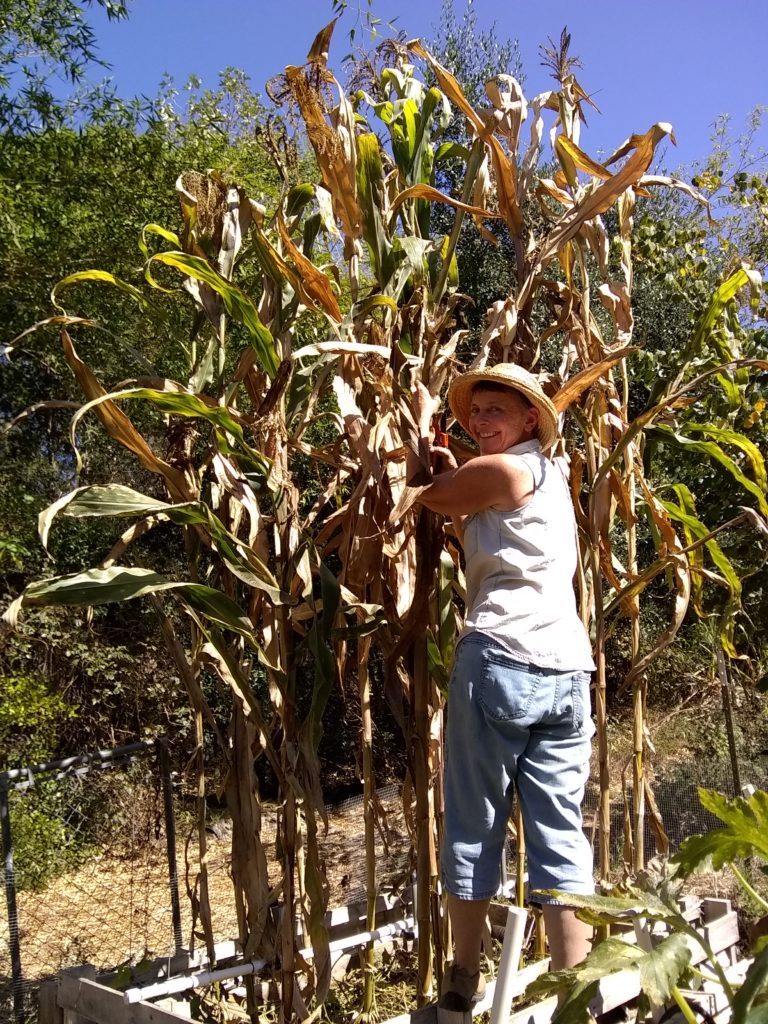
Trimming a few feet off the corn. I’m 5’3″ tall, for comparison. I have a phone in my back pocket and my pants are loose, so please don’t think I’m that saggy! We cut the corn stalks down to about 8 feet; above that the stalk was a little weak, and the stalks would be tall enough for our purposes. Then we planted vining (not bush) peas in and around the base of the corn. We had a lot of success with King Tut peas last year, which had beautiful purple pods (but green peas), so we opted for more of these in this bed.

Miranda planting around the corn. We left some of the cut sweet potato vines we’d just harvested from this bed to help hide and protect the pea seeds, and to return nutrition back into the soil. Now the peas are growing rapidly, and we’ll be able to train them up the sturdy, straight corn stalks with the help of some twine. When the peas are done, we can either use the stalks all over again for another climber, depending upon how they last over winter, or we cut the corn and the pea plants at the surface of the soil and put the whole pile into a compost pile, or into another raised bed. Corn is a hungry plant, so the pea’s nitrogen-fixing capability will help restore fertility to that raised bed. Remember that we use no fertilizer other than in-bed composting using kitchen scraps, plant cuttings, manure from our hens, and leaves, and anything else that will decompose. The beds are being watered by salty well water, too.

Baby peas are shooting up quickly. To help deter mice we sprinkle red pepper flakes over the seeds, and Miranda makes up a spray bottle full of hot sauce and water and sprays the beds in the evenings.
Re-purposing is so fun, especially when the result is better soil, healthier plants, and less work for us!
- Breads, Gardening adventures, Health, Heirloom Plants, Hugelkultur, Permaculture and Edible Forest Gardening Adventures, Planting, Recycling and Repurposing, Seeds, Soil, Vegan, Vegetables, Vegetarian
Growing Cornmeal


Sweet corn is a wonderful summer treat; although you can freeze it, is never as good as picked, steamed and eaten within hours. However hard corn can be dried, ground and stored for use throughout the year. Some varieties that aren’t super sweet can be eaten fresh or left to go hard for grinding. Miranda and I have fallen in love with growing and grinding colored corn. They are not just for Thanksgiving decorations anymore!
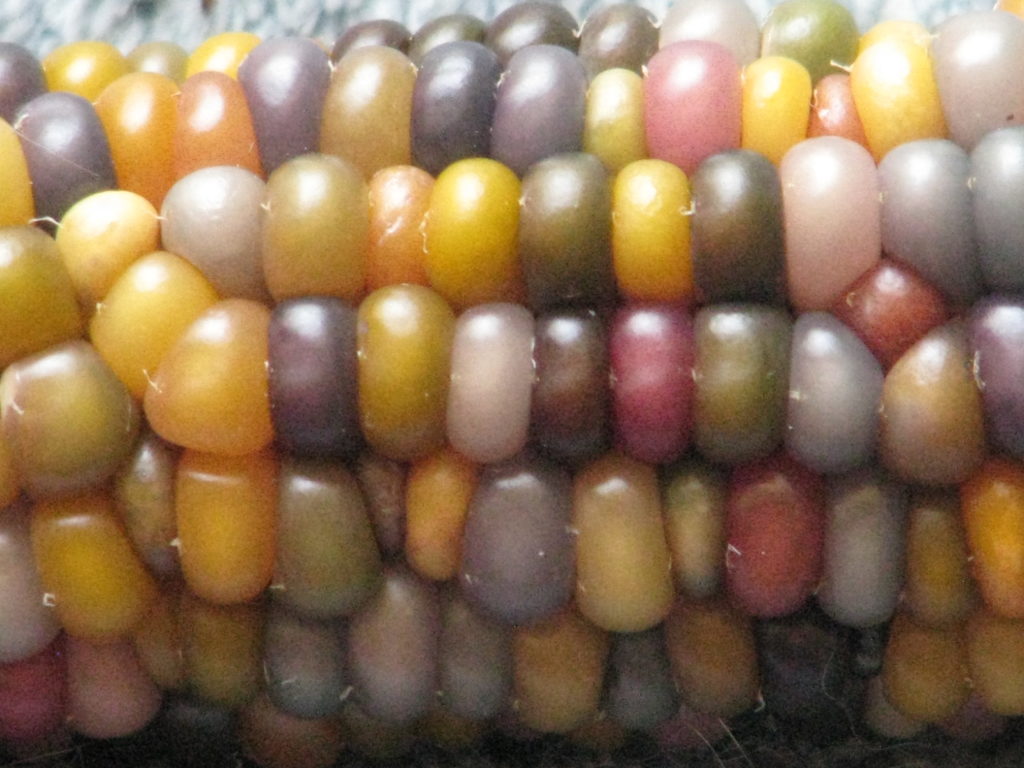
We’ve grown Indian corn and small cute popcorn. We’ve also grown the lovely Glass Gem Corn, with its opalescent pastel colors that was all the rage for the last few years. It made a lovely lightly colored cornmeal.

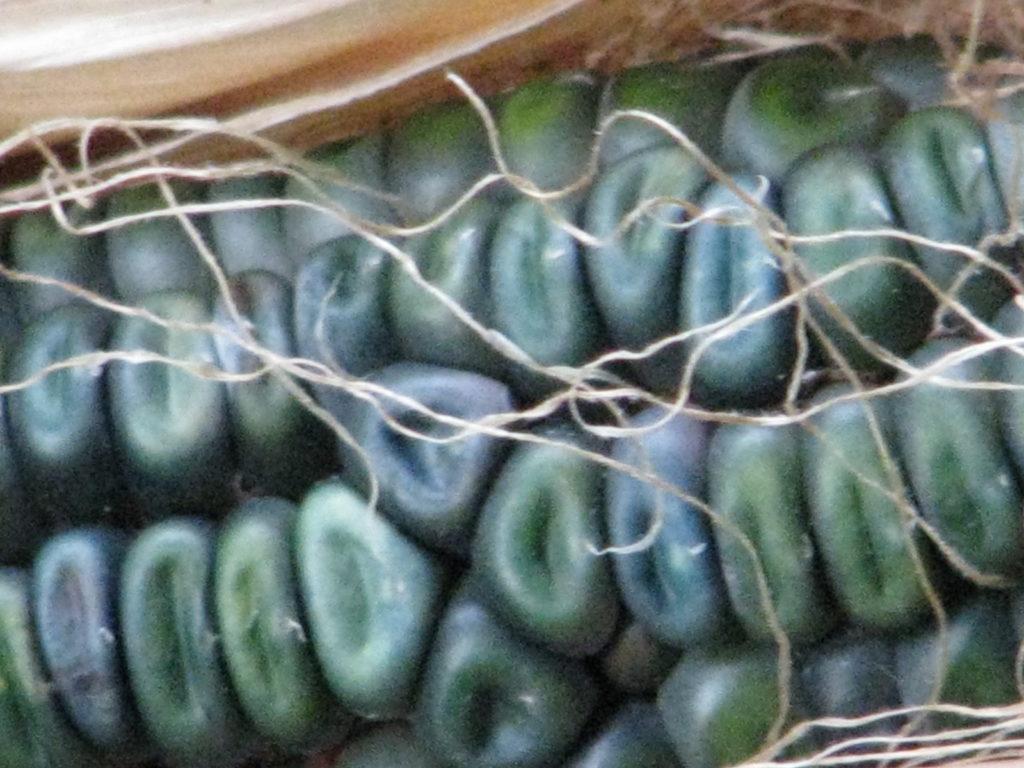
Last year we planted Oaxacan Green dent and black corn. Wow. The black corn was the most successful, growing about 12 feet tall.
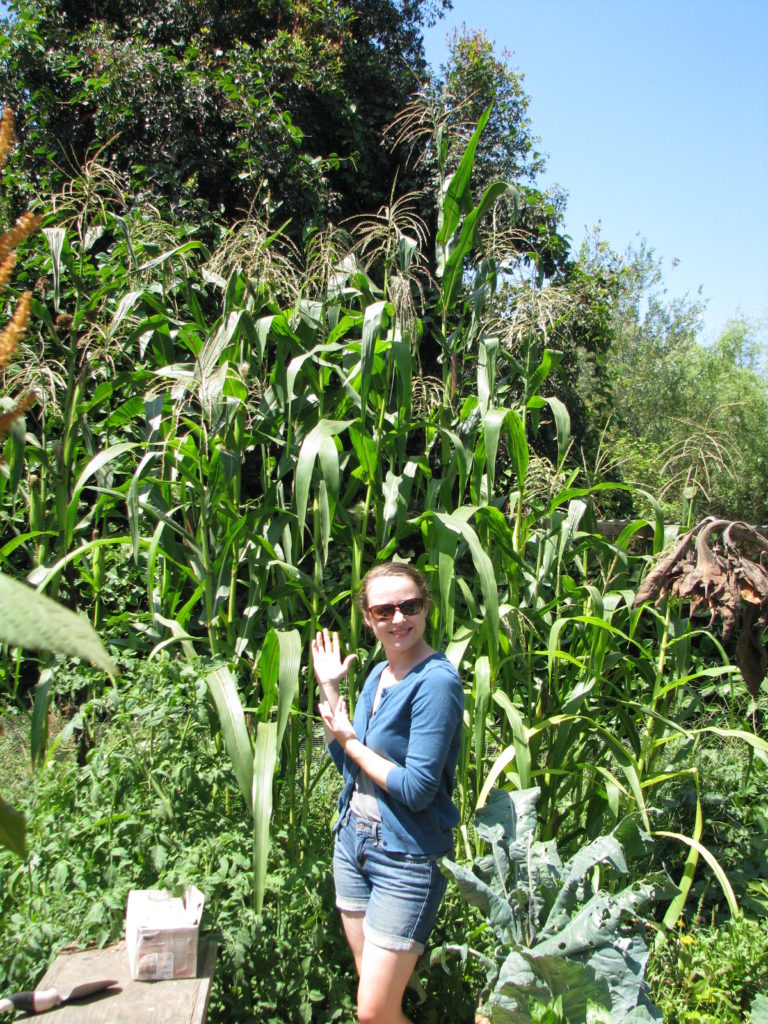
The black variety was Maiz Morado or Kulli Corn, from Baker Creek Heirloom Seeds. It had many aerial roots, which were black- actually a very deep purple- growing from several nodes.

The black corn began to peek out from the husks and it was magnificent.
We harvested the ears and let them lie on our warm porch out of the sun to finish drying. The stalks we tied up for Halloween and Thanksgiving decorations, and then they went into filling a raised bed.
When it came time to shuck the ears, we marveled at the color of the kernels. They were spectacular; so were the green dent.
Even better, the inside of the husks were colored, too. We dried them and saved them for tamales.

For New Year’s Eve, we stripped the dried kernels from the cobs; not a difficult process and one we could do in the evening after dinner while watching old Time Team reruns on YouTube.
When ground, the black corn meal was a light purple. We use our VitaMix’s special grain grinding container, but a normal one would work as well.
For tamales I guessed at a recipe, mixing half corn meal with half flour, a little baking powder and some vegan butter, and vegetable broth to wet. The mixture was very elastic and can certainly use work, but it was tasty and worked well to hold the filling together. The cornmeal turned a medium purple color when wet.
Soaking the husks to soften them was a treat, as their red color leached into the water making it look like wine.
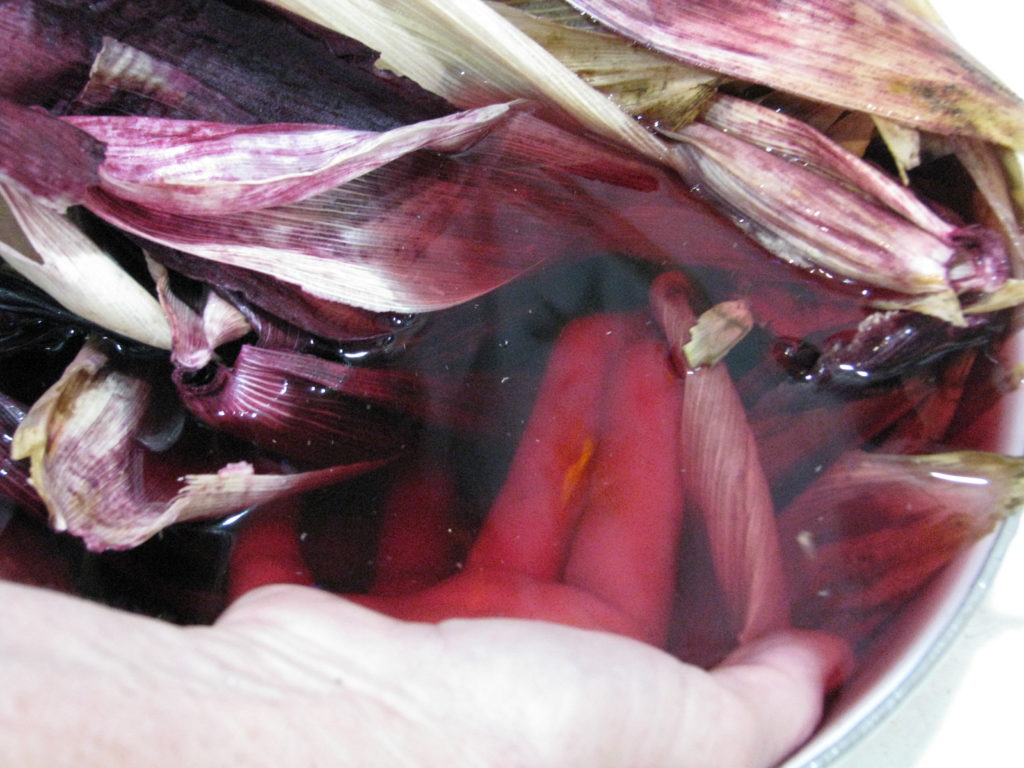
For fillings I couldn’t help but go with the whole purple theme, so I steamed one of our Molokai purple sweet potatoes which are an amazing purple as well.
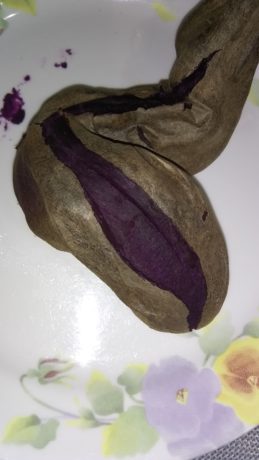
I also cooked up some of our frozen beet greens with onion, and used those two together with vegan cheese. A second filling was black beans mixed with cumin, oregano and our pickled carrots and jalapenos, and sweet corn with vegan cheese.

Miranda and I got such a kick out of all the colors, especially the purples. We couldn’t wait until they were steamed, which took about an hour and twenty minutes.
When the tamales were opened we were in awe. The black cornmeal had turned a very deep purple, and it was only half and half with flour! It was awesome. We enjoyed them with guacamole and, of course, our last Paul Robeson tomato because you just can’t have too many purple foods on your plate. The photo of the open tamale doesn’t do it justice.
We store the cornmeal in glass jars in the freezer. It makes excellent cornbread and cornmeal biscotti, as well as polenta and fried cornmeal mush. How fun and reassuring it is to use our own unsprayed, non-GMO cornmeal.
Coming up we’ll be planting black corn again, and a large patch of green dent as well; I want to see what pure green cornmeal looks like when cooked… maybe for Halloween dinner?

-
Always Time to be Grateful
Today, on Thanksgiving Day, Nov. 22, 2018, as on every other day there is so much to be thankful for. For waking up, for food, clean water and shelter, for friends and family, for the opportunities to volunteer and the ability to do so. this year at age 57 I returned to school, taking Horticulture classes at a local junior college to update my skills and knowledge. I overdid it with four classes, so my time management skills have been as severely tested as my ability to memorize and learn new concepts. Without my daughter’s help it would be less successful.
Finch Frolic Garden continues on and as we close the garden to the public for the winter, it remains open and thriving for wildlife seeking clean water, shelter and food as well. For my birthday, Miranda bought me a game camera which has recorded some interesting life in the bog area of the pond. Now we know why the irises are always smashed. The two glowing orbs from under the boat are just reflections, not a monster, but the ones from the pond are invasive bullfrogs. The juvenile red shouldered hawk has been walking around in the bog several times. Pond life is full of surprises!

MOULTRIE DIGITAL GAME CAMERA 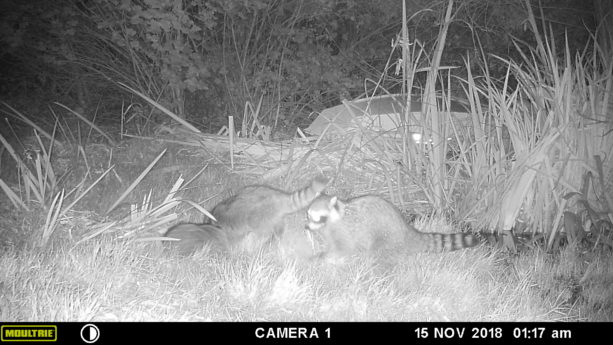
MOULTRIE DIGITAL GAME CAMERA 
MOULTRIE DIGITAL GAME CAMERA 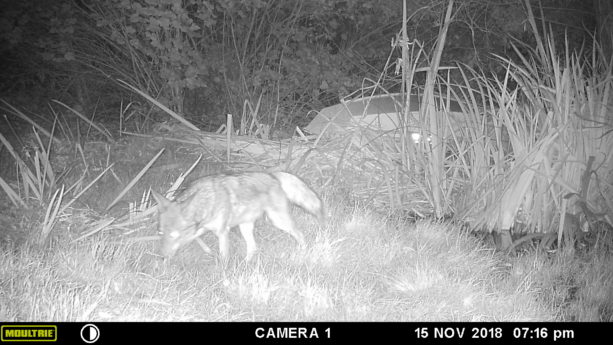
MOULTRIE DIGITAL GAME CAMERA 
MOULTRIE DIGITAL GAME CAMERA 
MOULTRIE DIGITAL GAME CAMERA We didn’t burn this go round with wildfires. We are maintaining, and therefore are so grateful for everything that we have, even the troubles that we have as they are not as severe as so many other’s. I am especially grateful to have a permaculture habitat so that these animals can survive.
Have a wonderful Thanksgiving everyday.
https://youtu.be/xcStEV4QiUE
-
We Host the Smallest Bats in the United States
 Our seven year-old chemical-free food forest habitat became the release site for an adorable pair. Two young rescued brothers that had been cared for by Cindy, a Project Wildlife/SD Humane Society bat team volunteer needed a safe, comfortable, food-rich home.
Our seven year-old chemical-free food forest habitat became the release site for an adorable pair. Two young rescued brothers that had been cared for by Cindy, a Project Wildlife/SD Humane Society bat team volunteer needed a safe, comfortable, food-rich home.  These two were Canyon bats, the western pipistrelle (Parastrellus hesperus) which are members of the smallest bat species in the United States. Their wingspan is at longest 8″, and their furry brown bodies are only about 6″ long.
These two were Canyon bats, the western pipistrelle (Parastrellus hesperus) which are members of the smallest bat species in the United States. Their wingspan is at longest 8″, and their furry brown bodies are only about 6″ long.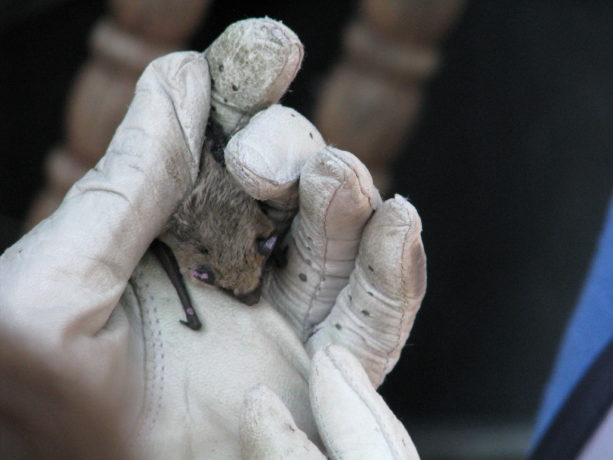 These insectivores are crepuscular, meaning they feed around sunset and dawn rather than during the night. They are also not colonial bats, but are often on their own eating the mosquitoes, beetles, small moths and flies around your home. Females will usually bear twins, rare for a bat, in June, and live either by themselves or in a small maternity colony. Here in October, these two little bats were from an early summer birth and were more than ready to get out of the rescue flight cage and be off on their own.
These insectivores are crepuscular, meaning they feed around sunset and dawn rather than during the night. They are also not colonial bats, but are often on their own eating the mosquitoes, beetles, small moths and flies around your home. Females will usually bear twins, rare for a bat, in June, and live either by themselves or in a small maternity colony. Here in October, these two little bats were from an early summer birth and were more than ready to get out of the rescue flight cage and be off on their own. 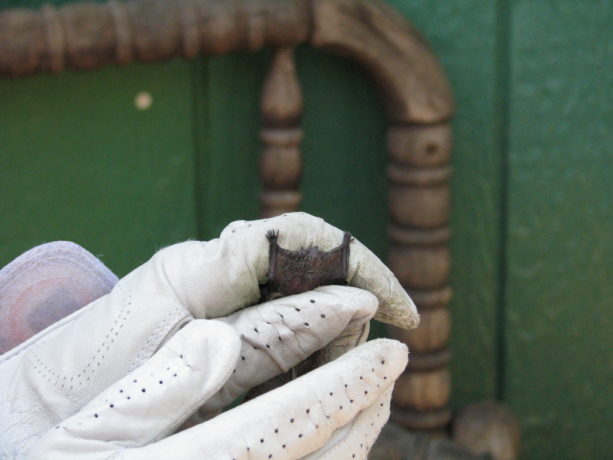
They were carefully allowed to crawl up into a bat house that had been hanging empty for five years. It was facing east so as to warm in the morning, and protected from the hot afternoon sun. The inside of the bat house had rough textured wood so the very tiny little feet had texture on which to grab. We made sure than there were no containers such as buckets or nursery cans facing up; many young bats fall in and can’t get out.

It was close to our chemical-free unlined pond for easy bug access at dining times, and which has enough open space for swooping across to get a mouthful of water. They may return to the bat house, or they may fly off to find a rocky nook or tree crevice that they like better, but we sure love them being released in our garden.
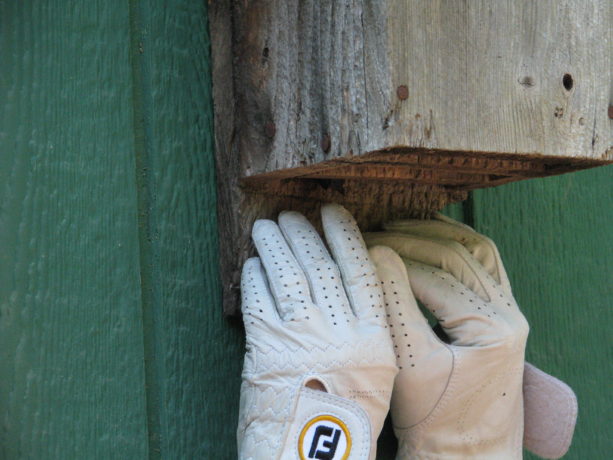
In permaculture, all the animals: bats, lizards, frogs, birds etc. are vital parts of the integrated pest management system as stated by pest control st paul, and also contribute to soil fertility with their droppings, sheds, feathers, leftover meals and bodies. When you spray for insects you kill the food supply for these animals which has effects throughout the food chain. Gardens should be alive with native wild animals and insects, and not reduced to only a scavenging ground for invasive rats and domestic cats.
At dusk or early in the morning keep an eye out for bat species in your yard. They are working to keep the insect population in control.
Project Wildlife | San Diego Humane Society
San Diego County is one of the most biologically diverse areas in the United States with the greatest number of endangered species. People from all over the county bring wildlife patients to Project Wildlife for care and we are proud to be a resource that our neighbors can depend on in order to coexist peacefully with wild animals.
- Animals, Bees, Gardening adventures, Grains, Health, Heirloom Plants, Herbs, Other Insects, Permaculture and Edible Forest Gardening Adventures, Planting, Seeds
Growing and Eating Seeds
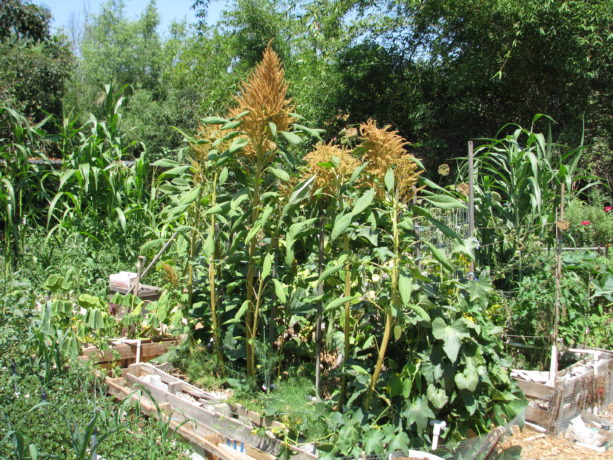 We eat seeds everyday. Grains, nuts, beans and, well, seeds, are all seeds. A seed is an embryonic plant covered with a seed coat. A grain is a dried fruit. In this blogpost I’m going to concentrate on true seeds.
We eat seeds everyday. Grains, nuts, beans and, well, seeds, are all seeds. A seed is an embryonic plant covered with a seed coat. A grain is a dried fruit. In this blogpost I’m going to concentrate on true seeds.Grains are usually seeds from grasses, although there are common exceptions to that rule such as the amaranth below. Seeds contain the magic that makes a plant out of a speck; a towering oak from an acorn. Seeds are highly nutritious for humans as well, but often are just used as a flavoring (think of an ‘everything’ bagel). Many have been used medically for relieving everything from eczema to mental issues. Some seeds such as grains are difficult to prepare for eating on a small scale, such as rice. Separating seeds from chaff takes a lot of steps that may not be practical for the handful of food at the end of the process. However there are many seeds that we commonly eat that are easily grown among the veggies, or even in a flower bed. Here are some that we grow at Finch Frolic Garden Permaculture:
Let’s start with one of my favorite flavors, the sesame seed.
 Sesame (Sesamum indicum) seeds grow on small upright plants about 2 – 3′ high that have lovely tubular flowers.
Sesame (Sesamum indicum) seeds grow on small upright plants about 2 – 3′ high that have lovely tubular flowers. 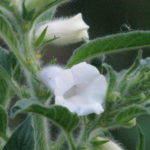 Bees love to crawl into them. Its a pretty plant and flower, so could easily be incorporated into an ornamental area. There are both black and white sesame seed plants; the white seed is really brownish as it has a seed coat. Sesame is also called benne seed. Once harvested sesame seeds should be stored in a dark cool place or refrigerated. The seeds can be used raw, or better still lightly toasted in a dry pan before sprinkling over your food. So very yum. Tip: sesame pods become tight as they dry and then split with force, throwing the seeds away from the plant. If you want to harvest any then watch the pods as they dry on the plant and then cut and hang in a paper bag to catch the seeds as they fly, or break open with your hands.
Bees love to crawl into them. Its a pretty plant and flower, so could easily be incorporated into an ornamental area. There are both black and white sesame seed plants; the white seed is really brownish as it has a seed coat. Sesame is also called benne seed. Once harvested sesame seeds should be stored in a dark cool place or refrigerated. The seeds can be used raw, or better still lightly toasted in a dry pan before sprinkling over your food. So very yum. Tip: sesame pods become tight as they dry and then split with force, throwing the seeds away from the plant. If you want to harvest any then watch the pods as they dry on the plant and then cut and hang in a paper bag to catch the seeds as they fly, or break open with your hands.Amaranth:
Amaranth (Amaranthus spp.) is a very tasty, easily grown seed that is considered a grain. It was a major food of the Aztecs, and almost completely destroyed by the Spanish after their conquest of that civilization. Amaranth was too sneaky though and survived. It is easily digestible, high in protein and full of other nutrition. It has wild as well as ornamental varieties, but all are edible (be sure what you are eating!) Love-lies-bleeding is the dramatic name of the long red tasseled kind.
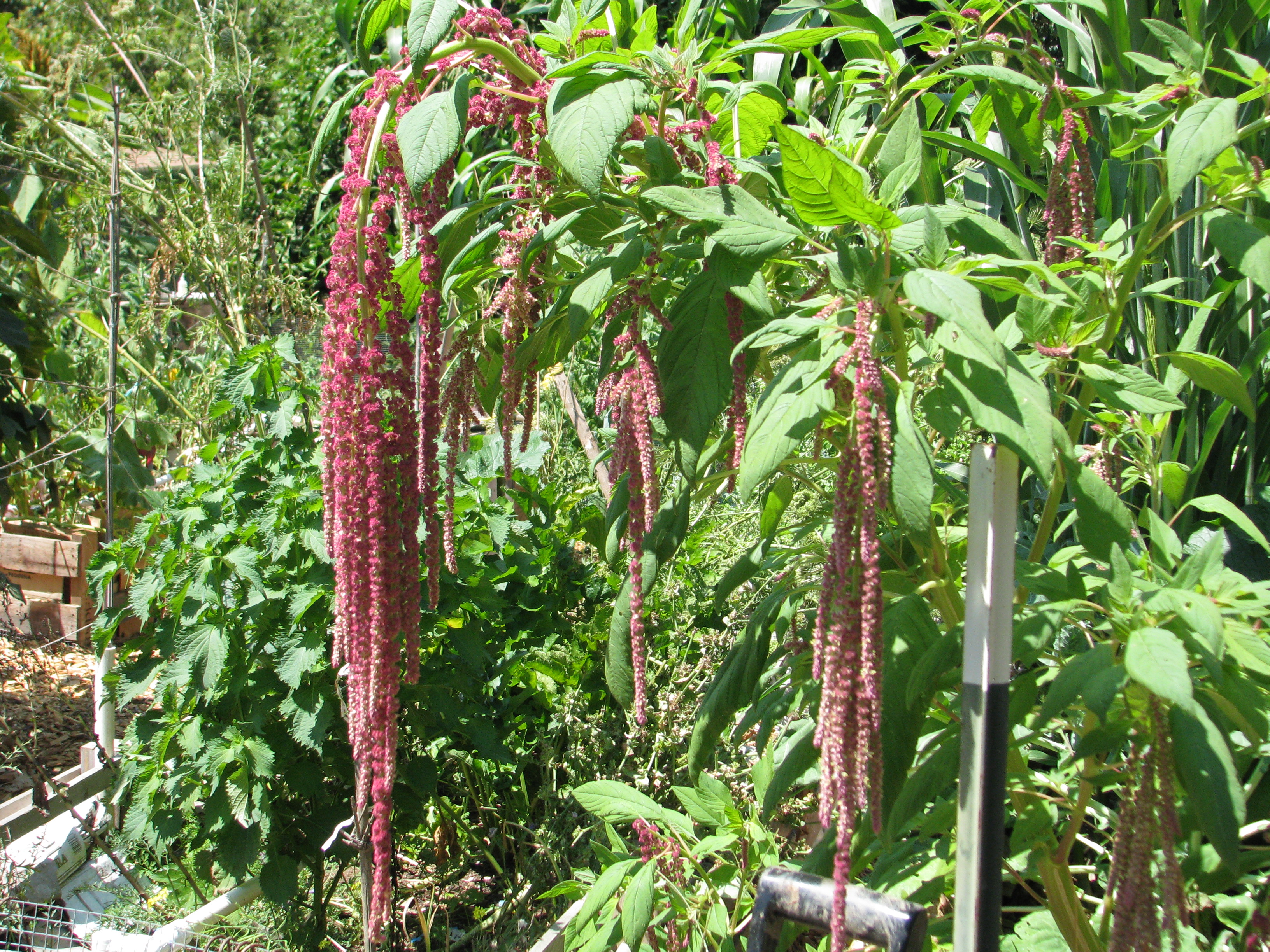

All are great for birds as well as humans.
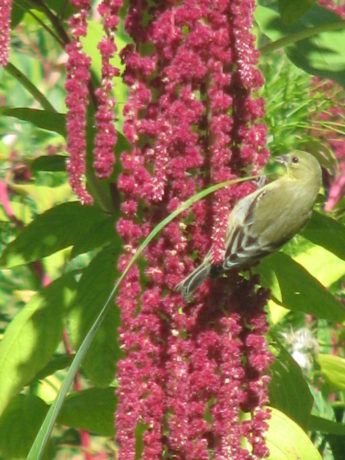
Pigweed and lambsquarter are its weedy relatives. All of them have edible leaves, although some varieties are more tasty than others. Older leaves are better cooked. The tall varieties can grow 8′ tall or so, may need staking, and make good shade plants for others that need sun protection. When you start to see birds on the flowers then the seed should be ready. Another way to check is to gently rub the flowers between your fingers and see if seeds come off as well as the petals. If so, then over a clean, dry bucket rub the cut flowers between your fingers. Winnow the chaff away over a mesh screen or in the wind, or by gently blowing it away from the seed. Now you need to completely dry the seed in the sun, and then store in a dry, dark cool place. Use within six months for best results.
Poppy seeds:
 No, not the opium kind, the lemon-poppy seed cake kind, although both are varieties of Papaver somniferum. Look for seeds for Breadseed Poppy varieties. This is another beautiful ornamental with striking seed pods that can be dried and used in flower arrangements. Poppies enjoy poor, disturbed soil. The seeds are tiny so need to be exposed to daylight to germinate. The flowers are beautiful; frail and feminine. The seed pods are rounded and have tiny holes at the top where the seeds come out of, so be careful when you are working around the drying pods or you’ll scatter seeds. Or just let some drop and they will come up next year.
No, not the opium kind, the lemon-poppy seed cake kind, although both are varieties of Papaver somniferum. Look for seeds for Breadseed Poppy varieties. This is another beautiful ornamental with striking seed pods that can be dried and used in flower arrangements. Poppies enjoy poor, disturbed soil. The seeds are tiny so need to be exposed to daylight to germinate. The flowers are beautiful; frail and feminine. The seed pods are rounded and have tiny holes at the top where the seeds come out of, so be careful when you are working around the drying pods or you’ll scatter seeds. Or just let some drop and they will come up next year.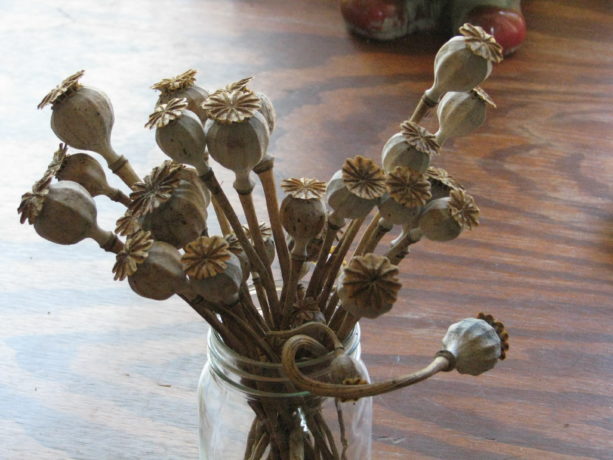
 Allow the pods to dry on the stem and then carefully cut. Shake the seeds out into a jar and store in a cool, dark place. Use raw or lightly toasted. Be sure not to eat them before taking a drug test, or you’ll test positive.
Allow the pods to dry on the stem and then carefully cut. Shake the seeds out into a jar and store in a cool, dark place. Use raw or lightly toasted. Be sure not to eat them before taking a drug test, or you’ll test positive.Basil seeds:
 Basil seeds aren’t well known for their culinary use in the US, but they are nutritious and useful. The seeds of the sweet basil plant (Ocimum basilicum) not Holy Basil (Ocimum tenuiflorum), when soaked make the water gelatinous, as chia seeds do, so are used to thicken drinks and foods. You don’t have to soak basil seeds to use them though. The flowers are delightfully edible as well. Use them for additional flavor and nutrition by tossing them raw into salads, salad dressing, breads, or just about anything. Letting some of the basil plant go to seed (while pinching other stems to keep it leafing) will attract small native pollinators to your garden. When the flowers dry, the seeds are ready to be shaken off into a clean, dry bucket or bag.
Basil seeds aren’t well known for their culinary use in the US, but they are nutritious and useful. The seeds of the sweet basil plant (Ocimum basilicum) not Holy Basil (Ocimum tenuiflorum), when soaked make the water gelatinous, as chia seeds do, so are used to thicken drinks and foods. You don’t have to soak basil seeds to use them though. The flowers are delightfully edible as well. Use them for additional flavor and nutrition by tossing them raw into salads, salad dressing, breads, or just about anything. Letting some of the basil plant go to seed (while pinching other stems to keep it leafing) will attract small native pollinators to your garden. When the flowers dry, the seeds are ready to be shaken off into a clean, dry bucket or bag. Coriander:
You probably know cilantro or Chinese parsley as the love-it-or-hate-it herb found in salsas and many Mexican or East Indian dishes. Cilantro (Coriandrum sativum) seed is called coriander. Coriander seed is usually used ground and used in curry mixtures, soups and meat dishes. It is an historical herb, being used in ancient India, China and Egypt. It has a kind of lemony taste that is unique.
Celery seeds:
Celery (Apium graveolens) seeds are marvelous savory additions to soups, particulary tomato. I grind it up in a mortar and throw it in soups and stews to round out the flavor. We grew celery one year -although I have no photos of it – and because of the warm weather the celery stalk flavor was quite strong. However the seeds were delightful. Celery is a cool-season plant and the stalks should be covered to keep pale green and mild flavored. Or just let them grow for the seed. There is a wild variety that grows in marshlands, but please be very careful if you harvest from it because it looks similar to the very poisonous water hemlock (Cicuta).
Fennel:
If you’ve sipped ouzo, aguardiente or anisette, you’ve tasted the seeds of the fennel plant. Fennel (Foeniculum vulgare) is the brother of anise, and both have escaped gardens to be a troublesome weed. Fennel bulbs are absolutely amazing lightly steamed, and then baked in vegan butter and topped with vegan Parmesan. The leaves are fantastic stirred into eggs or salads, and the seeds are incredible flavorings for baked goods, candies and obviously alcohols. Miranda candied fennel seeds for me. They have been used to try and mask cigarette or alcohol breath, but really… who is kidding who? They do make a great breath freshener chewed. The plants are frondy, tall and have pretty umbels of flowers that native insects love.
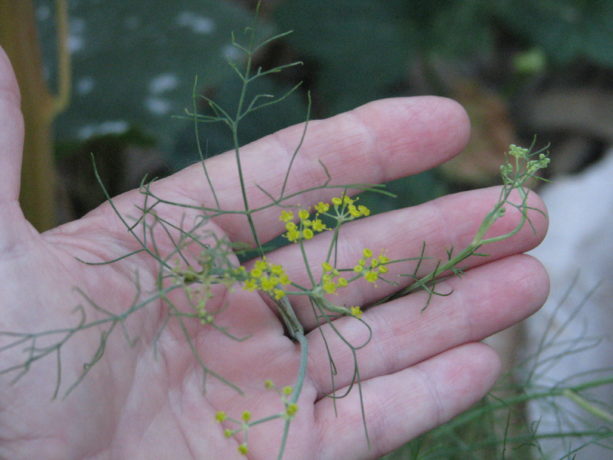 Grow some for the bulbs (protect them from gophers!) and let others go to seed. Cut and hang upside down to collect the seed in a bag or else you’ll have fennel everywhere. And that may not be a bad thing.
Grow some for the bulbs (protect them from gophers!) and let others go to seed. Cut and hang upside down to collect the seed in a bag or else you’ll have fennel everywhere. And that may not be a bad thing.Sunflower
I don’t know anyone who isn’t familiar with sunflower seeds; certainly the shells were routinely spit out all over campus as a cool snack when I was in college and probably still are. At least they are biodegradable. Sunflowers (Helianthus annuus) are one of the few edible seeds native to North America, and they are protected in an attractive hull. Some varieties are small, multi stemmed and ornamental, and others are grown for their fabulously large seed heads. Birds love eating the green leaves as part of their healthy diet, so grow extra. The seed heads should be left to dry on the stalk, and then cut and shaken to de-seed. Good pollination is important to produce seeds with good ‘meat’ inside.
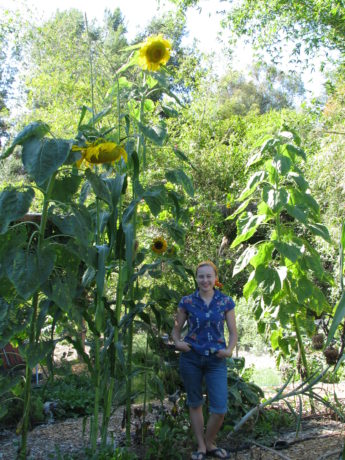
Eat them raw or toasted; they are full of good things for your body. (Miranda is 5’1″ in the photo, not tiny. I like that one of the heads seems to be checking her out.)
Dill
Dill (Anethum graveolens) is another double happiness plant. The leaves are tremendous used fresh or dried, and the seeds are fantastic as well. We use the whole seed heads in our dill pickle recipe. It goes well with fish, or in our case vegan fish. Grind them or use them whole, but definitely stir them into sauces, soups, dressings, dips, etc. Dill, like fennel, will reseed, but that isn’t a bad thing. They look pretty much like the fennel plant above.
Caraway:
We’ve grown caraway (Carum carvi) in the past, but I have no picture for you. Just refer to the photo above of the fennel and it will be close, as they are in the carrot family. You’ll find caraway in rye breads, liquors and cheeses, and in some areas the young leaves and roots are also eaten. They are dried and harvested just like the fennel and dill.
There are other seeds that we haven’t grown. We’ve tried to grow cumin and annatto seeds, but have failed to make them germinate; there is always next year. Some seeds are so small, such as chia, that you’d have to grow a lot of plants to harvest just a little seed. Seeds are such a vital nutritional and flavorful part of our diets, and so fun to grow that everyone should sprinkle edible seed-bearing plant seeds throughout their garden. As seeds dry and keep fresher longer than dried leaves (such as basil or dill), that fresh taste of the garden can last through until next year’s harvest time again.
